#I’m putting videos in google drive and then putting them in drafts and deleting as I go
Explore tagged Tumblr posts
Text
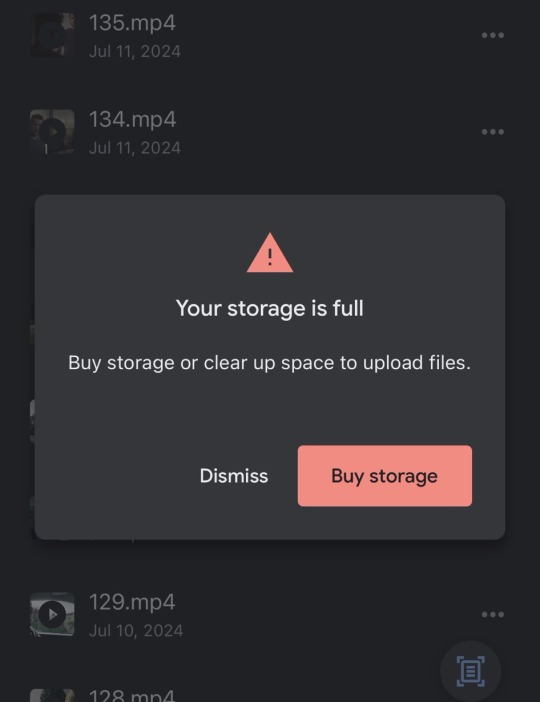

organizing this is a part time job in of itself
#I’m putting videos in google drive and then putting them in drafts and deleting as I go#do you know#how long#it takes for a video to save#in drafts#SIX#six show
15 notes
·
View notes
Text
A Single Step and Then Another
Writing is no small feat. Ever since I was bitten by the writing bug, I’ve struggled with keeping projects afloat and maintaining interest in blog management. Before Tumblr, I tried to start a blog twice on Blogspot (now known as Blogger). Much of that came from my desire to track my days. Like keeping a diary or journal. But interesting things were far and few between. The days of my youth largely blurred together and I could hardly find the time to sit down and jot down my thoughts on school or university.
During primary school, when computers were still churlish machines that chugged along at a snail’s pace, I tried my first attempts at writing fanfiction. I didn’t know what it was called at the time, but my curiosity led me to tease out what happened after the Happily Ever After’s that were promised in certain Disney films such as Snow White and the Seven Dwarfs. As ever, I proved an astute business woman, selling my perfectly printed books that were stapled on one side on the market for $2 a pop.
Alas, the only person that bought my works of genius was my mother.
High school was when I rediscovered my hobby. I was already an avid reader. Writing, while a more difficult challenge, once more sunk its claws into me. As always, I wrote to entertain - imagining daring mercenaries in a fantasy world or anthropomorphic animals clinging to a dying kingdom. Most were inspired by the stories I read and the video games I played. Many of the characters were named after my friends or were poor caricatures.
There were times, however, when I was writing that I wondered if perhaps I was stealing too many tropes from such classics as Eragon and the Fire Emblem franchise. As such, I often hewed and hawed over many of my works. By the end of high school, I deleted the one major story that I had sitting on my FictionPress. Mostly because I had no proper idea of where I wanted the narrative to go. And I was just filling it up with utter nonsense.
Yet the idea of a mercenary and a hidden princess persisted. I tried to use it again in my next writing project. Still, the land of Thlandaris never quite reached my lofty expectations. Changing everyday animals into weird fantasy creatures with fantastical names also didn’t help.
And so my writing stalled once again.
It was not until I began working, however, that I found my way back again to the world of writing. Though I hadn’t opened up a blank Word page in a while (at least for anything other than a university assignment or a job application), ideas aplenty danced and tossed around in my head. That, of course, was when I decided to restart my attempts at keeping a blog. Yes, I knew it would never really transpire into something majorly popular (though the hope remained that one of my many articles would become viral and a newspaper would decide to feature it), but I thought it would assist with my attempts at writing.
The going, however, was slow when I began work on Divided We Fall. The story itself went through three drafts. With the last one being the most complete. And while I would have sorely liked to have edited it, it had taken a good four years to arrive at what I had been hoping for. Even during those gruelling years of crafting the characters of Feryden, Elisander, Kiralt and Lathin (who were based on many of my earlier characters), I was also tempted by starting up a new project. Like many before me, it was easy to simply toss away an idea that was taking too long and do something different.
Despite that, I decided to keep a record of my many ideas for future stories. After all, if I could just finish one, then surely I had accomplished something.
Back to Divided We Fall, I went. And gosh darn it, I finished it in 2018. Along the way, of course, I had written several short stories. And, I had also managed to be consistent with my blog updates. Yes, many were just impressions and reviews of the games I played - but churning out one a week was also nothing to scoff at.
But I still had ideas aplenty filling my head. While I was quite taken with the idea of writing a reinterpretation of Snow White, my dear friend Hayatedragoon convinced me to stick with my first idea. The one that I hoped would be published as a short series of books. The Adventures of Lacet and Idana.
Throughout the writing of my stories, there were many times when I wanted to give up or delete everything that I had written. As with most creative types with a hint of perfectionism, I was my own worst critic. No-one would like my characters, I said! My dialogue is atrocious! The singular starting sentence was not enough to capture the attention of readers!
With time, however, I managed to silence those thoughts (mostly). There are times, still, when I have wondered if it has all been worth the blood and sweat. It isn’t as if I have publishers and agents beating down my door. Nor do I have a thousand followers on FictionPress leaving me with positive reviews of the things I have written.
I will be honest, a part of me yearns for the praise. And my genius to be recognised. But to do so, however, would go against the very reason why I began writing. The reason why I wanted to write was to weave my own tales. To explore the stories of characters that do not usually get the spotlight. While Lacet and Idana follow many tropes that are stereotypical to the fantasy genre, I like to think I’ve subverted a few expectations. Lacet is no wise wizard. Nor is he young (and incredibly hot) upstart mage. He is middle-aged. His hair is balding and he has a bit of a stomach.
Of course, as more chapters of Wild Child are uploaded to my FictionPress, I cannot help but worry if my writing will fall into the trap that so many others have done. Will I have ruined the characters by putting too much of myself into them? Will they all become Mary Sues by the end of it all? Will I overcompensate and so they all become terribly unlikeable?
In other news, I finished editing Monsters Beneath My Bed a couple of months ago as well. Yet I’ve delayed uploading it until I’ve the entirety of Wild Child is up. And before I could even think to rest on my laurels, I began another short story (which is still in progress at time of writing up the blog post) and committed myself to another novel length story. This time, however, the genre is a departure from my usual stomping grounds. Forget fantasy. Let’s try and commit to a modern adventure/ thriller!
Already I am regretting my decision. Nothing seems factually accurate and I fear that my attempt might just be deleted given another month or two.
But I will persist. The key to forging ahead, at least for myself, is to worry not about how perfect the quality of the writing is. That is what the editing process is about. Of course, even after editing, slip-ups can still occur. But by carving out the crude gem can one polish it. Such is the process of writing. And if you think I’m talking out of my arse, well, the first few seconds of Neil Gaiman’s ad for his masterclass in writing also provided the perfect analogy of driving with one headlamp and hoping the editing will make people THINK you knew where the plot was going from the very start.
Getting caught up in the nitty gritty of the perfect prologue (for almost two years) did not allow me to craft the entirety of the story. Nor did it allow me much exploration of the characters and other important facets of the world.
So, for those that are thinking of trying to write their own masterpiece, all I can say is start it as soon as the idea comes. And never waver. Sure, it might not be as good as you hoped, but all of that can be fixed later on. Also, never be afraid to look up synonyms on Google (or a thesaurus).
But what I found helpful as well was to learn by reading widely. I mean, authors were published for a reason, right? Let them inspire you on your own writing journey. And question what you can make better.
3 notes
·
View notes
Text
I’ve included my full process post first draft so this is long as fuck. TLDR: Edit content. Rewrite. Edit for readability and spelling/grammar. Critique partner reads and gives feedback. Edit for content. Edit for readability and spelling/grammar. Consider plans for manuscript and take next steps accordingly.
Drafting
My edit actually starts before I finish my manuscript. Inevitably some things change as I draft but I don’t let myself get stuck going back and rewriting a scene because I’ve had a new idea. Instead I do something Hank Green once recommended in a Vlogbrothers video and I write the change that needs to be made into a Word document called ‘Changes - >insert story title<’ so that I can come back to it for the first edit.
Mental Distance
The first thing I do after I finish my first draft is put the book down for a month. Three weeks might work, but two isn’t enough. I really think a month is the sweet spot. I don’t read my manuscript, but I also try to distract my mind away from that WIP for the month. I avoid the playlists, I don’t make moodboards, or pinterest boards, I don’t make the characters in the Sims, I do not look at my outline.
You need to remove yourself from the state of mind you were in when drafting and give yourself distance from the manuscript, story, and characters overall.
I personally find a fanfiction binge is great for this. Reread something that always makes you want to read fanfic, go read fanfic, half give in to the urge to write a super long fanfic. Plan it a bit but never follow through because when you think about the effort you remember how many original ideas you have that you want to write. Feel guilty that you enjoy the fanfic effort of others but no longer write it yourself. By the time that cycle is over, a month should have passed!
The First Re-Read
It’s time to reread the manuscript with fresh eyes! Open up your manuscript and your changes document. At this point make a copy of your outline. I recommend keeping a copy of your pre-draft outline so that if you lose your way while editing you can go back and look at the original plan. Name one copy of the outline accordingly so you know it’s the original and open up the other copy that you’ll be making changes to.
As I re-read I leave comments using the comments feature on Word or Google Docs. These comments are usually highlighting places I know I need to make changes. I keep track of wider changes in the changes document. I will dot point minor changes like ‘change Annie’s name to Bella’ and absolutely ramble on about bigger plot related changes. As I am noting the changes I need to make I am also updating my outline to reflect those changes.
The First Rewrite - All About Plot and Characterisation
Once the re-read is done we’re moving onto the re-write but first it’s time to address my outline. With all the new changes does it still flow and make sense? Is it following the story structure I originally planned with in a general sense? How does the pacing of events seem to you? Is there a section where a lot of quiet scenes happen without anything really gripping for a hundred pages? Might want to switch it up. I also take this moment to go back and look at the character profiles I’ve made, specifically I am looking at character motiviation to make sure that all the main players are acting according to their motivation, not just in a way that serves the plot. If you need a character to act consistently in a way that doesn’t match their current goal (what they think they want, usually isn’t what they need,) then you will need to either add additional motivation or change that goal entirely. Once I’m happy the character’s are acting in a way that makes sense based on what drives them still, it’s time for the rewrite.
This is where your list of changes will be fleshed out into a list of scene rewrites, scenes to add, scenes to delete, and small details I may need to change throughout the story. If you add something new and big to the story you also want to make sure this new thing is still addressed in scene’s you wrote before you thought of it. If it’s a character go and add them to existing scenes. If it’s a technology, magic, or smoking gun, time to add references to it. If you killed main character’s sister to motivate her then you should have the sister mentioned throughout so it seems like legitimate motivation. You get the idea.
Now you have a list of details to change, scenes to rewrite, scenes to write, and references to find places to add in, it’s time to write draft number two.
I personally do this rewrite in order and highly recommend this method because it allows you to, as you’re reading, find places to add those references to main character’s new dead sister, or the additional thing magic can do now, or whatever things you’ve added in and need to establish in the reader’s mind before they become a part of the plot / mention often so they seem important enough to motivate your character(s.)
Re-Read Again
Once you’ve crossed off all the items in your change document and resolved all the comment bubbles in your manuscript document, re-read your manuscript again without taking a break. Just make sure the entire thing is readable and all the scenes connect, you haven’t left any random sentences that trail off etc. Spelling and grammar is still not the focus but try to correct anything you catch.
More Distance
This distance is less intense than the first. I usually take one week to a month off for this stage and the deciding factor is solely how tired I am. We’re just trying to get some space from the manuscript so that you can do a spelling/grammar edit. Familiarity can make you miss obvious mistakes, it’s why you need a copy editor because both you and your developemental editor will grow blind to mistakes.
Edit Spelling and Grammar
I recommend downloading a checklist for this. You’re going to want to create your own, because we all have things we fuck up consistently. I can’t spell definitely, I literally spell checked it just now. Some people shift tenses a lot throughout the book. There’s all sorts of things. We’re nowhere near publishing so don’t kill yourself, but be through. The cleaner the manuscript the better.
Critique Partner Stage
Do you have a writing buddy? I sure hope so because you’ll need one for the next step. I really recommend finding someone who will take the time to read and critique your manuscripts in a timely manner and who you do the same for in return. The alternative is to pay someone. This service is called a Manuscript Critique, a Reader Report, and sometimes a Light Developmental Edit. And it is expensiveI I provide this service and I am SO cheap but frankly it’s still a lot of money for a service that isn’t a professional edit. It’s just one read through and a feedback sheet provided on things like worldbuilding, pacing, plot, characterisation etc. It’s essential, but I cannot stress how much I recommend saving your pennies
I’ve just gone to had a look at prices. Salt and Sage books charge $90 per 10K words, the average book is 80K words so that’s $720.00 for the full manuscript. Manuscriptcritique.com charge $1,560.00 for an 80K words manuscript. The Institute for Writers charges $ 6,400.00 for 55-80,000 words.
Comparatively I charge $50 per 10K words making an 80K manuscript $400 but of all the services I provide it is the only one I don’t recommend you buy from me or anyone else. Find a critique partner!!
I might do a post on finding critique partners at some point but here’s the basics. Your critique partner should be:
A writer themselves. Ideally someone at or above your level of skill and experience. You want someone who takes writing seriously and it is better if they write original work. This is especially true if you write fantasy/sci-fi or any genre that requires a lot of worldbuilding.
Someone who reads a Iot, ideally some of the books they read are in the genre you are writing. If they have no familiarity with your genre they aren’t a great match but you can make up for them with beta readers (who don’t have to be writers) that do read your genre.
Not a member of your family, romantic partner, or ‘real life’ friend. They cannot be trusted to give you honest feedback. The best friends and family will try not to hurt your feelings. But they may also try to discourage you by falsely telling you that your writing is terrible. There are lots of reasons they may do this and some of them do stem from misguided love, but overall. Friends and family are not it. A writing friend, as in someone you connected with through the writing community in some way, is the exception to this rule and in fact the IDEAL critique partner.
Not a person who suffers from people pleasing, a deep fear of hurting people’s feelings, or excessive niceness.
Not the kind of person who likes to start drama, get a rise out of people, says ‘I’m just being honest’ to excuse saying rude things to others, or just a general asshole and/or cunt.
So now you’ve found your critique partner, they’ve read your manuscript and they’ve got notes. Hopefully they have mastered the art of the shit sandwich and have thrown in enough praise alongside the critisim that you don’t want to fling yourself off a bridge. Even if they haven’t resist the urge. Take your time to digest their feedback. Don’t just plain accept it and do exactly what they recommend. It’s YOUR book. Consider the merit of what they have to say and make a new list of things you want to change.
The Second Rewrite
I won’t go into it in detail, repeat all the steps from the first rewrite. Around this stage is usually when I have a crisis and change something big. Just keep updating the changes sheet and implementing the changes. When you’re done, do a reread to make sure it’s good and then it’s time to -
Think About What You Want To Do
Your next steps depend entirely on what you want to do with this manuscript.
It’s totally okay to read the manuscript, appreciate yourself for the hard word you’ve done and all you learned drafting and rewriting it and decide that you’re not going ahead with publication. Either because you don’t want to, or maybe you want to write a few more books and hone your skills before making your debut.
If you decide you DO want to publish you’ve got to decide how before we continue. Self-publishing? Or traditional?
If You Don’t Want To Publish
I recommend doing a final edit for grammar and spelling, in part for the practice but also because I highly recommend that you make yourself a copy of the book as a testement to the achievement of writing and editing it. There’s two main ways to do this:
1. Just print it.
Change the font in word. Play around with the formatting a bit. Give yourself proper chapters, a title page, a table of contents, maybe a dedication page. Design a cover using Canva (it’s free and very easy) and make it take up the entire first page of the manuscript. Print that shit out and decide how you’re going to bind it. You can just staple holes in the pages and use page fasteners. You can pay to have it bound (it can be surprisingly affordable at large stationary chain stores. However you want to go about it.
2. Use Amazon.
What I do and I personally think it’s genius. Make an Amazon kdp account not in the name you want to publish under. Publish your book but don’t add any tags so no one can find it, put in a one line bio that’s really vague (you need a bio to get approved) and put the book at the lowest price you can.
Next you create a paperback version of your book. Amazon have their own program for formatting your document, you upload it, choose one of their fonts and play around with adding in title pages, table of contents, etc. It’s very easy to use but there’s plenty of YouTube videos explaining how. Still make your cover in Canva or wherever you like and upload it to their formatting program. When you’re happy save the file and upload it.
Amazon are print on demand so all of this costs exactly nothing. Upload your book to Amazon. Then buy a copy of it. Once your copy has been printed and shipped, remove it from the Amazon store but leave your book unlisted in your kdp. Now you get a print copy of your book and you’ve copyrighted it. Copyright is instant in most countries, once you’ve made it technically speaking you have copyright but if someone stole your book you’d need to be able to prove it’s yours. With your Amazon account you can prove it even if someone destroys your laptop with all the backups and steals the paperback. I’m not paranoid, you’re paranoid.
If You Do Want To Publish
It’s time to do some research. Self-publishing and traditional publishing are such processes to get there and this post is already extremely long. But suffice to say, if you want to publish you’ll be doing another rewrite because we still have beta readers, editors, and maybe an agent who are going to give you feedback.
Writers who have written/completed a second draft of a story, how did you go about it/what did that process look like for you?
be as detailed or brief as you would like, just know your responses will probably go on to help a fellow writer.
#writing#writing advice#amwriting#amediting#editing advice#writing tips and tricks#writers tips and tricks#writers#writer's#writing community#writer's community#mywritingadvice
18 notes
·
View notes
Text
The SEO Tool Kit: 11 Tools That’ll Save You Time
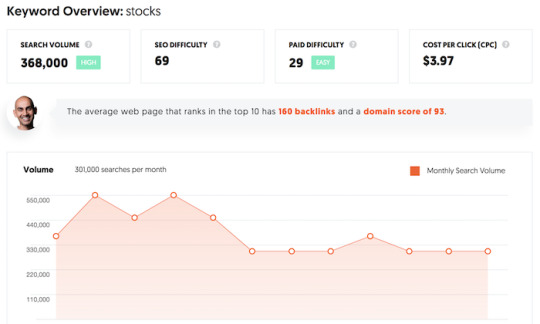
When I first got into the world of SEO, you could literally optimize your site for any term and rank at the top of Google within a month or two.
But of course, that was ages ago.
Now with Google’s ever-evolving algorithm, it takes more time and effort to get results.
But what happens if you don’t have the luxury of time? Or you don’t have the financial resources to put in the effort that is truly needed.
What should you do?
Just forget about SEO?
Of course not. Today, I want to call out 11 tools that will help you get an edge over your competition. But unlike most lists, I am going to get very specific on the feature I want you to use within each tool to make your life easier and help you get results faster with less effort.
Let’s dive right in.
Tool #1: Ubersuggest Projects
You probably already know about Ubersuggest, but do you really have time to spend hours and hours each week to do your SEO?
Chances are you don’t.
So how do you improve your traffic with the least amount of effort?
You set up a project in Ubersuggest.
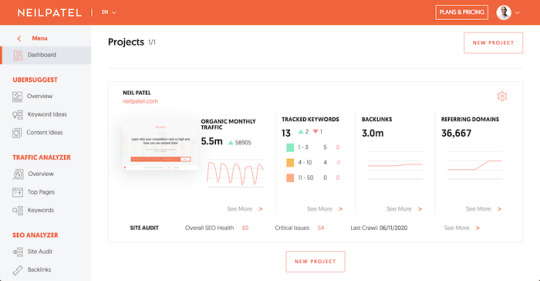
As you can see, it shows your SEO traffic over time. It will let you know if your rankings are going up or down, your link growth, and your SEO issues.

With so many things going on in marketing, you don’t have time to manually check your rankings or if things are going up or down or even what you need to fix.
Ubersuggest will do it for you all automatically and even notify you of what needs to happen through email. That way you don’t have to constantly check your SEO. Ubersuggest will do it all automatically.
More so, you’ll get notified of what you need to focus on each week to maximize your traffic.
All you have do is head to the dashboard and click on “Add Your First Project.”
It’s as simple as adding in your URL.

Then select the locations you do business in and want traffic from.
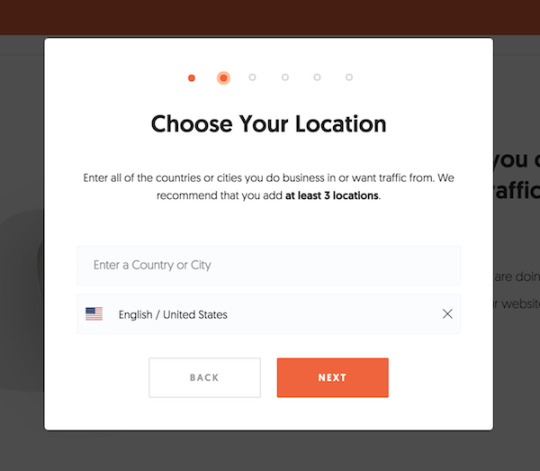
Then add in the keywords you currently rank for or want to go after.
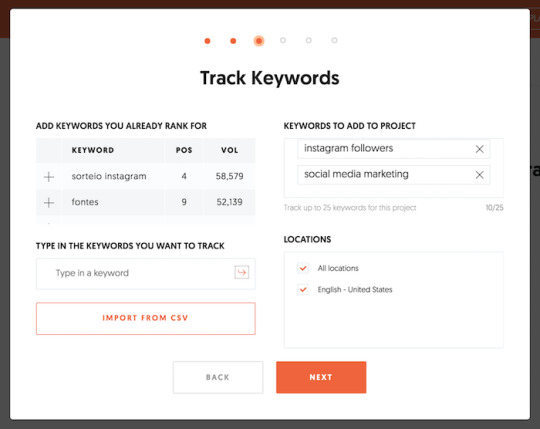
And of course, set up your traffic preferences.

And then you’ll be good to go.
Then when things go great, you’ll be notified. And when things are going wrong, you’ll also be notified. Ubersuggest will even tell you what to fix.
That way you get the maximum results in the least amount of time.
Tool #2: Google Analytics Alerts
You have Google Analytics set up on your site, but how often do you log in?
And when you do log in, do you know what to focus on or what to look at?
And if you do, do you know what to do with that data?
Google Analytics is a great tool, but you don’t want to waste hours and hours looking at reports. Instead, you want to spend your time doing and getting results.
But if you set up alerts in Google Analytics, you can save tons of time.
youtube
If you watch from the 6:33 mark, it will show you how to set up alerts. I added the whole video as it will teach you how to set up Google Analytics in general in case you don’t have goal tracking set it place.
Once you set up alerts, you’ll again get notified when anything good or bad happens. I usually have alerts set up for only when things go bad, so I know when I need to focus on fixing my marketing.
Tool #3: Trello
You’re probably thinking how the heck is Trello a marketing tool. It really isn’t, but it is a good project management tool.
And with your SEO, you may have a team helping you out and Trello will help streamline the process, make you more efficient, and get your results faster.
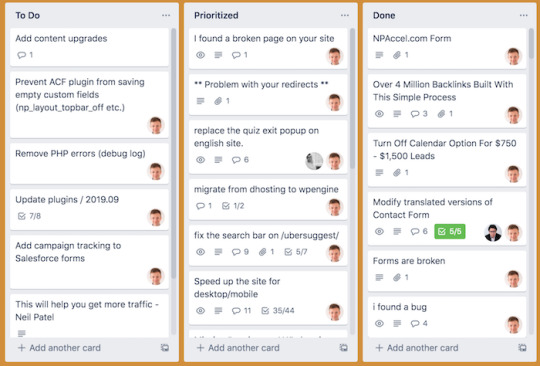
I keep my Trello board simple by breaking it into 3 sections.
To do – what needs to be done over time.
Prioritized – what I need to be done now (tasks at the top are the most important)
Done – tasks that need to be double-checked to ensure they were done right.
It’s that simple. That way you don’t have to micromanage your team.
Some people have more complex Trello boards, but something simple like I have worked too.
If you want to create a Trello board for your content marketing, assuming you want to write lots of content (such as 10 posts a week), this process works well.

The columns I use for content writers are:
Topics – this is where writers add topics they want to write about.
Outline review – writers submit their outline before they write for approval.
Draft – writers submit their rough draft.
Draft review – editors review each draft.
Uploaded, prepared, and ready to review – this is where the editor adds the post to your CMS (like WordPress).
Scheduled – this is where you schedule the content to go live.
Done – the content is now live.
We’ve found it effective if you are managing dozens of writers at once.
Tool #4: Content Decay Tool
Can you guess how many articles I write each week?
1.
Seriously, that’s it. 1 article a week which is roughly 4 to 5 per month (depending on how many weeks in the month).
And can you guess how many articles my team and I update each week?
21.
That’s roughly 90 a month.
Just think about it… why would I have a team of 3 people updating 90 articles per month when I only write 1 a week.
It’s because updating old content is an easier way to get more SEO traffic than it is to create new content.
But what content should you update?
The content decay tool will tell you that.
youtube
It breaks down in order which articles you should update first, second, third… based on what will generate you the most traffic.
If you are wondering what is involved with updating content, just think of it this way:
Is there anything outdated within your post – if so, either update the outdated information and make it relevant again. If you can’t, then delete that part from your article.
Can you use media to improve the experience – do you need to embed videos, add more pictures, maybe even add an infographic? Use media to better tell your story and message.
Are you including the right keywords – a simple way to get more traffic is to integrate other popular related keywords within your article. Whatever your article is about, insert it into Ubersuggest and head to the “Keyword Ideas” report in the left-hand navigation.
Is there anything missing – try to poke holes within your content. What could you have done to make it better? What do your competitors talk about that you forgot to mention? What questions didn’t you answer that the reader might have? By asking yourself these simple questions, you’ll be able to make it better.
Tool #5: Ubersuggest Chrome Extension
If you haven’t installed the Ubersuggest Chrome extension, make sure you do so.
I’m not going to bore you with all of the features of the extension… instead, I am going to give you one thing that will save you time.
You know when you Google for information to learn more on any subject?
Chances are, sometimes you are Googling to learn something related to your space. And when you do, you’ll find that your site usually won’t be at the top of those search results.
And that’s ok.
But when you do a search, you’ll notice “monthly searches” in the Google search bar.

This shows you how often that keyword is searched.
So anytime you are looking up anything in your space, pay attention to that number. If you see a keyword with over 5,000 searches, it may be worth targeting.
And as you scroll down and start going through the sites that rank at the top, you’ll notice metrics under each site.
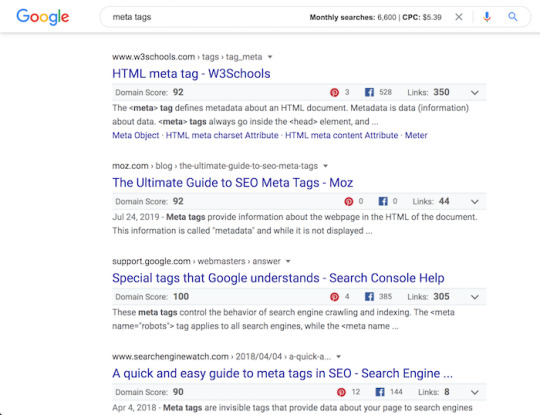
If you notice a web page with thousands of social shares and hundreds of links, it should reaffirm that you probably want to go after that term. And the listing that has thousands of social shares and hundreds of links is a good benchmark of a page that is high in quality and what people in your space prefer.
Ideally, you want to create something better than that one, as that is the main way you beat them over time.
Tool #6: Hello Bar
SEO is very different than paid traffic.
With paid traffic, you can drive people to a landing page with very little content, which makes it easier to generate sales or leads.
With SEO, Google prefers to rank content-rich sites.
But when someone lands on a page full of educational-based content, they are less likely to convert into a customer.
There’s a simple fix… Hello Bar.
Hello Bar has a lot of features, but I just want you to use the top bar like I do on NeilPatel.com.
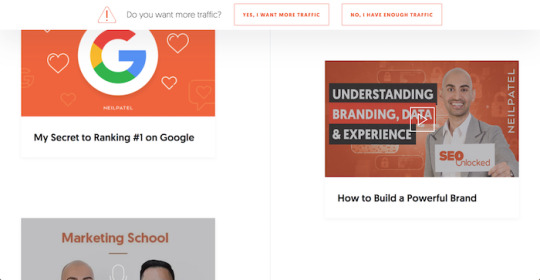
And as you scroll it moves along with you.
That one little thing allows me to improve my conversion rate from my SEO traffic.
You can easily adjust what you show with a few simple clicks within Hello Bar or you can even show people different messages based on where they are coming from.

Although SEO traffic doesn’t convert as well as paid traffic, it is much cheaper in the long run and does have a better overall ROI. And that one little Hello Bar will improve your numbers.
It’s responsible for 9.4% of revenue from NeilPatel.com.
Every little bit adds up.
Tool #7: Mozcast
Google makes over 3,200 algorithm changes a year.
Are you really going to keep up to date with all of them?
If you followed the first tool and set up a project in Ubersuggest, you’ll get notified when your rankings go down.
And if you set up alerts in Google Analytics (tool number 2) you’ll also get notified when your traffic drops drastically.
What you’ll find is that it’s overwhelming to keep up with all of Google’s updates and it could be confusing to figure out what you need to fix to get your traffic back.
This report on Moz keeps track of all of the algorithm updates and gives you an overview of what has changed or what the update is about. On top of that, you’ll want to check out the Mozcast if you get a notification of ranking or traffic drops as this tool confirms if other people are also seeing changes from a Google update.
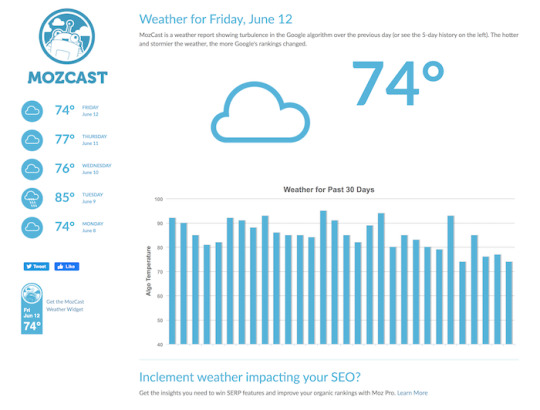
Keep in mind that Google doesn’t announce each update, hence you’ll want to cross-reference what you are seeing with the Mozcast.
That way you don’t have to spend hours researching each update.
Tool #8: Detailed
Link building is a pain. There are so many link tools like this one… but let’s not kid ourselves… you just don’t have the time to spend 10 to 20 hours a week doing link building.
So, each minute you spend, you have to make sure it counts.
There’s a tool called Detailed that breaks down the best links for every industry.
All you have to do is select an industry and a site and it shows you all of the good links that are going to your competition.

You can then focus your efforts on reaching out to those sites to get links.
Sure, you will still need to have amazing content or a good product or service in order to convince those sites to link to you, but hey, if you don’t have any of that it’s going to be hard to do well in the first place.
So, don’t waste your time trying to search for links when Detailed will give you a list of hundreds of amazing sites to get links from within your space.
Tool #9: Site Speed Audit
Speed impacts rankings.
Google doesn’t want to rank slow websites anymore.
It doesn’t matter that technology has become better and you can now purchase satellite Internet. Not every location has blazing fast Internet.
For that reason, Google has an Accelerated Mobile Pages framework that helps with mobile load time.
But that’s not enough, you also need your website to load fast.
So, go here and put in your URL.
You’ll then be taken to a report that looks like this:
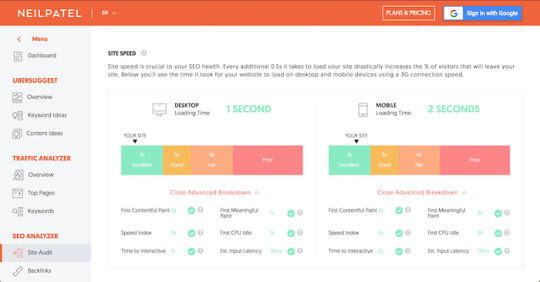
What’ll you want to focus on is site speed. That Ubersuggest report pulls from Google Lighthouse.
So, send that to your developer and tell them to get you in the green mark for both mobile and desktop load times.
As your speed goes up, so will your SEO rankings and traffic over time.
Tool #10: Supermetrics
Are you tired of having your data everywhere?
Why would you want to log into four of five different apps to get your SEO and marketing data when you could log into one.
And no, I am not talking about Google Analytics. I am talking about Google Data Studio.
If you haven’t used it yet, sign up for it… it’s free.

Google Data Studio is a business intelligence tool that will show you all of your data in one place.
So how do you get all of your SEO data into Google Data Studio? You use Supermetrics.
It passes all of your SEO data from different sources into Data Studio, so you no longer have to log into multiple tools, including Google Analytics.
My favorite feature in Supermetrics is you can automate your marketing reporting, so you no longer have to create your reports manually.
Tool #11: VidIQ
Google is the most popular search engine.
But do you know what the second most popular search engine is?
It’s not Bing… it’s actually YouTube, which Google actually owns.
If you haven’t done YouTube SEO yet, you should reconsider. Just look at how much search traffic I get from YouTube each month.

This article will break down how to do YouTube SEO if you want to learn how it works.
But to make things easier, install this Chrome extension.

Whenever you perform a search on YouTube it will show you what’s popular, what keywords are being searched that are related to each video, and which tags people are using to get more SEO traffic.
I wanted to end this post with VidIQ because it’s not competitive.
See, unlike traditional SEO, it doesn’t take months to see results. YouTube SEO is the opposite in which it isn’t as competitive (yet) and you can rank at the top within 24 to 48 hours of releasing a video (seriously!).
Conclusion
They say SEO is hard and time-consuming. And I am not going to lie, you won’t get results unless you put in some effort.
But who says it has to be as time-consuming?
By using some of the tools I mentioned above you’ll save time. It really is that simple.
I know there is a lot and it can be overwhelming. So if you don’t have time to use all of the tools it is fine… just start at the top and work your way down (I put them in order based on what will save you the most time).
What other ways do you save time on your SEO?
The post The SEO Tool Kit: 11 Tools That’ll Save You Time appeared first on Neil Patel.
Original content source: https://neilpatel.com/blog/seo-tool-kit/ via https://neilpatel.com
The original post, The SEO Tool Kit: 11 Tools That’ll Save You Time, has been shared from https://imtrainingparadise.wordpress.com/2020/06/16/the-seo-tool-kit-11-tools-thatll-save-you-time/ via https://imtrainingparadise.wordpress.com
0 notes
Text
The SEO Tool Kit: 11 Tools That’ll Save You Time

When I first got into the world of SEO, you could literally optimize your site for any term and rank at the top of Google within a month or two.
But of course, that was ages ago.
Now with Google’s ever-evolving algorithm, it takes more time and effort to get results.
But what happens if you don’t have the luxury of time? Or you don’t have the financial resources to put in the effort that is truly needed.
What should you do?
Just forget about SEO?
Of course not. Today, I want to call out 11 tools that will help you get an edge over your competition. But unlike most lists, I am going to get very specific on the feature I want you to use within each tool to make your life easier and help you get results faster with less effort.
Let’s dive right in.
Tool #1: Ubersuggest Projects
You probably already know about Ubersuggest, but do you really have time to spend hours and hours each week to do your SEO?
Chances are you don’t.
So how do you improve your traffic with the least amount of effort?
You set up a project in Ubersuggest.

As you can see, it shows your SEO traffic over time. It will let you know if your rankings are going up or down, your link growth, and your SEO issues.

With so many things going on in marketing, you don’t have time to manually check your rankings or if things are going up or down or even what you need to fix.
Ubersuggest will do it for you all automatically and even notify you of what needs to happen through email. That way you don’t have to constantly check your SEO. Ubersuggest will do it all automatically.
More so, you’ll get notified of what you need to focus on each week to maximize your traffic.
All you have do is head to the dashboard and click on “Add Your First Project.”
It’s as simple as adding in your URL.
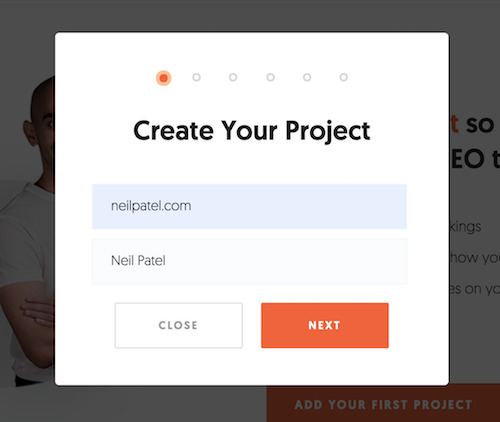
Then select the locations you do business in and want traffic from.
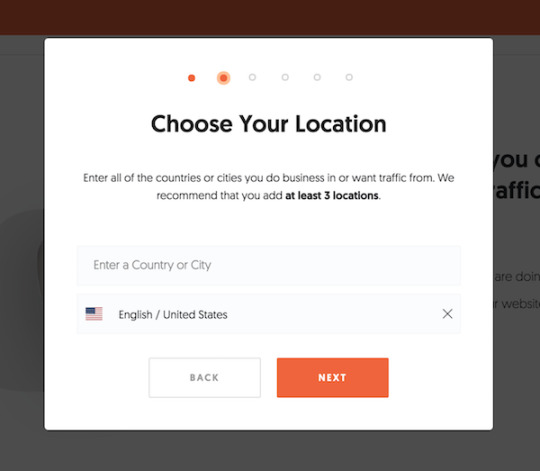
Then add in the keywords you currently rank for or want to go after.

And of course, set up your traffic preferences.
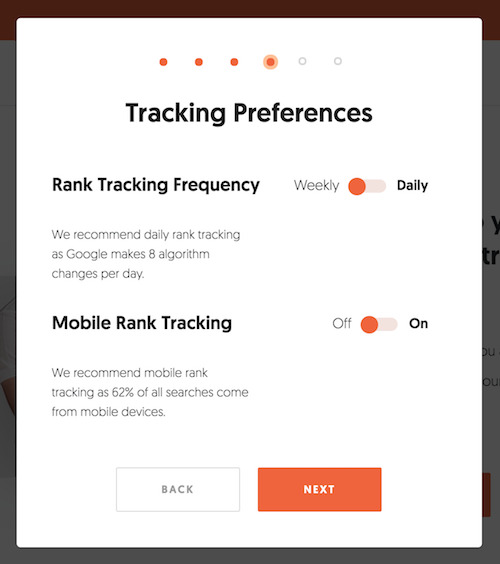
And then you’ll be good to go.
Then when things go great, you’ll be notified. And when things are going wrong, you’ll also be notified. Ubersuggest will even tell you what to fix.
That way you get the maximum results in the least amount of time.
Tool #2: Google Analytics Alerts
You have Google Analytics set up on your site, but how often do you log in?
And when you do log in, do you know what to focus on or what to look at?
And if you do, do you know what to do with that data?
Google Analytics is a great tool, but you don’t want to waste hours and hours looking at reports. Instead, you want to spend your time doing and getting results.
But if you set up alerts in Google Analytics, you can save tons of time.
youtube
If you watch from the 6:33 mark, it will show you how to set up alerts. I added the whole video as it will teach you how to set up Google Analytics in general in case you don’t have goal tracking set it place.
Once you set up alerts, you’ll again get notified when anything good or bad happens. I usually have alerts set up for only when things go bad, so I know when I need to focus on fixing my marketing.
Tool #3: Trello
You’re probably thinking how the heck is Trello a marketing tool. It really isn’t, but it is a good project management tool.
And with your SEO, you may have a team helping you out and Trello will help streamline the process, make you more efficient, and get your results faster.

I keep my Trello board simple by breaking it into 3 sections.
To do – what needs to be done over time.
Prioritized – what I need to be done now (tasks at the top are the most important)
Done – tasks that need to be double-checked to ensure they were done right.
It’s that simple. That way you don’t have to micromanage your team.
Some people have more complex Trello boards, but something simple like I have worked too.
If you want to create a Trello board for your content marketing, assuming you want to write lots of content (such as 10 posts a week), this process works well.

The columns I use for content writers are:
Topics – this is where writers add topics they want to write about.
Outline review – writers submit their outline before they write for approval.
Draft – writers submit their rough draft.
Draft review – editors review each draft.
Uploaded, prepared, and ready to review – this is where the editor adds the post to your CMS (like WordPress).
Scheduled – this is where you schedule the content to go live.
Done – the content is now live.
We’ve found it effective if you are managing dozens of writers at once.
Tool #4: Content Decay Tool
Can you guess how many articles I write each week?
1.
Seriously, that’s it. 1 article a week which is roughly 4 to 5 per month (depending on how many weeks in the month).
And can you guess how many articles my team and I update each week?
21.
That’s roughly 90 a month.
Just think about it… why would I have a team of 3 people updating 90 articles per month when I only write 1 a week.
It’s because updating old content is an easier way to get more SEO traffic than it is to create new content.
But what content should you update?
The content decay tool will tell you that.
youtube
It breaks down in order which articles you should update first, second, third… based on what will generate you the most traffic.
If you are wondering what is involved with updating content, just think of it this way:
Is there anything outdated within your post – if so, either update the outdated information and make it relevant again. If you can’t, then delete that part from your article.
Can you use media to improve the experience – do you need to embed videos, add more pictures, maybe even add an infographic? Use media to better tell your story and message.
Are you including the right keywords – a simple way to get more traffic is to integrate other popular related keywords within your article. Whatever your article is about, insert it into Ubersuggest and head to the “Keyword Ideas” report in the left-hand navigation.
Is there anything missing – try to poke holes within your content. What could you have done to make it better? What do your competitors talk about that you forgot to mention? What questions didn’t you answer that the reader might have? By asking yourself these simple questions, you’ll be able to make it better.
Tool #5: Ubersuggest Chrome Extension
If you haven’t installed the Ubersuggest Chrome extension, make sure you do so.
I’m not going to bore you with all of the features of the extension… instead, I am going to give you one thing that will save you time.
You know when you Google for information to learn more on any subject?
Chances are, sometimes you are Googling to learn something related to your space. And when you do, you’ll find that your site usually won’t be at the top of those search results.
And that’s ok.
But when you do a search, you’ll notice “monthly searches” in the Google search bar.

This shows you how often that keyword is searched.
So anytime you are looking up anything in your space, pay attention to that number. If you see a keyword with over 5,000 searches, it may be worth targeting.
And as you scroll down and start going through the sites that rank at the top, you’ll notice metrics under each site.

If you notice a web page with thousands of social shares and hundreds of links, it should reaffirm that you probably want to go after that term. And the listing that has thousands of social shares and hundreds of links is a good benchmark of a page that is high in quality and what people in your space prefer.
Ideally, you want to create something better than that one, as that is the main way you beat them over time.
Tool #6: Hello Bar
SEO is very different than paid traffic.
With paid traffic, you can drive people to a landing page with very little content, which makes it easier to generate sales or leads.
With SEO, Google prefers to rank content-rich sites.
But when someone lands on a page full of educational-based content, they are less likely to convert into a customer.
There’s a simple fix… Hello Bar.
Hello Bar has a lot of features, but I just want you to use the top bar like I do on NeilPatel.com.
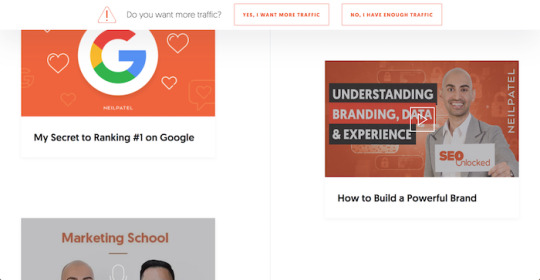
And as you scroll it moves along with you.
That one little thing allows me to improve my conversion rate from my SEO traffic.
You can easily adjust what you show with a few simple clicks within Hello Bar or you can even show people different messages based on where they are coming from.

Although SEO traffic doesn’t convert as well as paid traffic, it is much cheaper in the long run and does have a better overall ROI. And that one little Hello Bar will improve your numbers.
It’s responsible for 9.4% of revenue from NeilPatel.com.
Every little bit adds up.
Tool #7: Mozcast
Google makes over 3,200 algorithm changes a year.
Are you really going to keep up to date with all of them?
If you followed the first tool and set up a project in Ubersuggest, you’ll get notified when your rankings go down.
And if you set up alerts in Google Analytics (tool number 2) you’ll also get notified when your traffic drops drastically.
What you’ll find is that it’s overwhelming to keep up with all of Google’s updates and it could be confusing to figure out what you need to fix to get your traffic back.
This report on Moz keeps track of all of the algorithm updates and gives you an overview of what has changed or what the update is about. On top of that, you’ll want to check out the Mozcast if you get a notification of ranking or traffic drops as this tool confirms if other people are also seeing changes from a Google update.

Keep in mind that Google doesn’t announce each update, hence you’ll want to cross-reference what you are seeing with the Mozcast.
That way you don’t have to spend hours researching each update.
Tool #8: Detailed
Link building is a pain. There are so many link tools like this one… but let’s not kid ourselves… you just don’t have the time to spend 10 to 20 hours a week doing link building.
So, each minute you spend, you have to make sure it counts.
There’s a tool called Detailed that breaks down the best links for every industry.
All you have to do is select an industry and a site and it shows you all of the good links that are going to your competition.
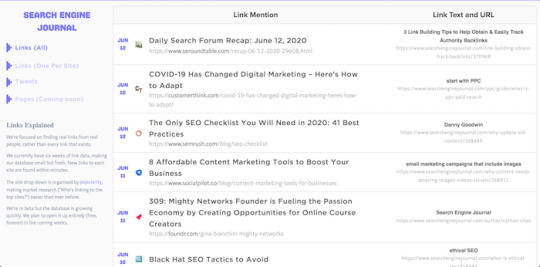
You can then focus your efforts on reaching out to those sites to get links.
Sure, you will still need to have amazing content or a good product or service in order to convince those sites to link to you, but hey, if you don’t have any of that it’s going to be hard to do well in the first place.
So, don’t waste your time trying to search for links when Detailed will give you a list of hundreds of amazing sites to get links from within your space.
Tool #9: Site Speed Audit
Speed impacts rankings.
Google doesn’t want to rank slow websites anymore.
It doesn’t matter that technology has become better and you can now purchase satellite Internet. Not every location has blazing fast Internet.
For that reason, Google has an Accelerated Mobile Pages framework that helps with mobile load time.
But that’s not enough, you also need your website to load fast.
So, go here and put in your URL.
You’ll then be taken to a report that looks like this:
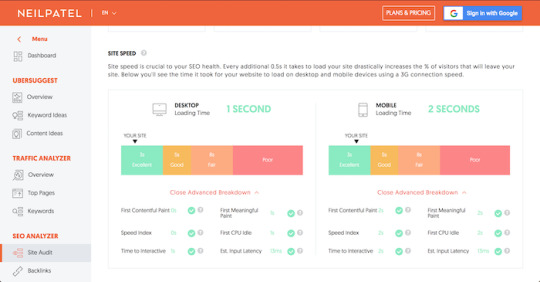
What’ll you want to focus on is site speed. That Ubersuggest report pulls from Google Lighthouse.
So, send that to your developer and tell them to get you in the green mark for both mobile and desktop load times.
As your speed goes up, so will your SEO rankings and traffic over time.
Tool #10: Supermetrics
Are you tired of having your data everywhere?
Why would you want to log into four of five different apps to get your SEO and marketing data when you could log into one.
And no, I am not talking about Google Analytics. I am talking about Google Data Studio.
If you haven’t used it yet, sign up for it… it’s free.

Google Data Studio is a business intelligence tool that will show you all of your data in one place.
So how do you get all of your SEO data into Google Data Studio? You use Supermetrics.
It passes all of your SEO data from different sources into Data Studio, so you no longer have to log into multiple tools, including Google Analytics.
My favorite feature in Supermetrics is you can automate your marketing reporting, so you no longer have to create your reports manually.
Tool #11: VidIQ
Google is the most popular search engine.
But do you know what the second most popular search engine is?
It’s not Bing… it’s actually YouTube, which Google actually owns.
If you haven’t done YouTube SEO yet, you should reconsider. Just look at how much search traffic I get from YouTube each month.
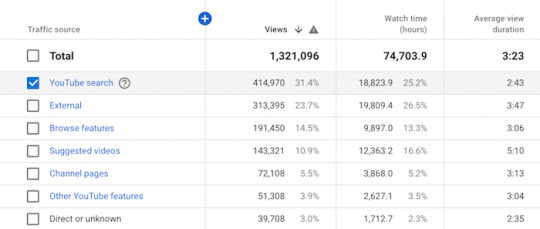
This article will break down how to do YouTube SEO if you want to learn how it works.
But to make things easier, install this Chrome extension.

Whenever you perform a search on YouTube it will show you what’s popular, what keywords are being searched that are related to each video, and which tags people are using to get more SEO traffic.
I wanted to end this post with VidIQ because it’s not competitive.
See, unlike traditional SEO, it doesn’t take months to see results. YouTube SEO is the opposite in which it isn’t as competitive (yet) and you can rank at the top within 24 to 48 hours of releasing a video (seriously!).
Conclusion
They say SEO is hard and time-consuming. And I am not going to lie, you won’t get results unless you put in some effort.
But who says it has to be as time-consuming?
By using some of the tools I mentioned above you’ll save time. It really is that simple.
I know there is a lot and it can be overwhelming. So if you don’t have time to use all of the tools it is fine… just start at the top and work your way down (I put them in order based on what will save you the most time).
What other ways do you save time on your SEO?
The post The SEO Tool Kit: 11 Tools That’ll Save You Time appeared first on Neil Patel.
The SEO Tool Kit: 11 Tools That’ll Save You Time Publicado primeiro em https://neilpatel.com
0 notes
Text
The SEO Tool Kit: 11 Tools Thatll Save You Time

When I first got into the world of SEO, you could literally optimize your site for any term and rank at the top of Google within a month or two.
But of course, that was ages ago.
Now with Google’s ever-evolving algorithm, it takes more time and effort to get results.
But what happens if you don’t have the luxury of time? Or you don’t have the financial resources to put in the effort that is truly needed.
What should you do?
Just forget about SEO?
Of course not. Today, I want to call out 11 tools that will help you get an edge over your competition. But unlike most lists, I am going to get very specific on the feature I want you to use within each tool to make your life easier and help you get results faster with less effort.
Let’s dive right in.
Tool #1: Ubersuggest Projects
You probably already know about Ubersuggest, but do you really have time to spend hours and hours each week to do your SEO?
Chances are you don’t.
So how do you improve your traffic with the least amount of effort?
You set up a project in Ubersuggest.
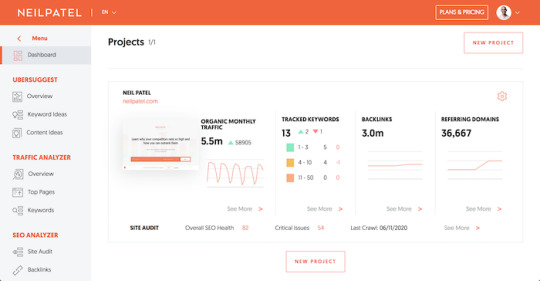
As you can see, it shows your SEO traffic over time. It will let you know if your rankings are going up or down, your link growth, and your SEO issues.
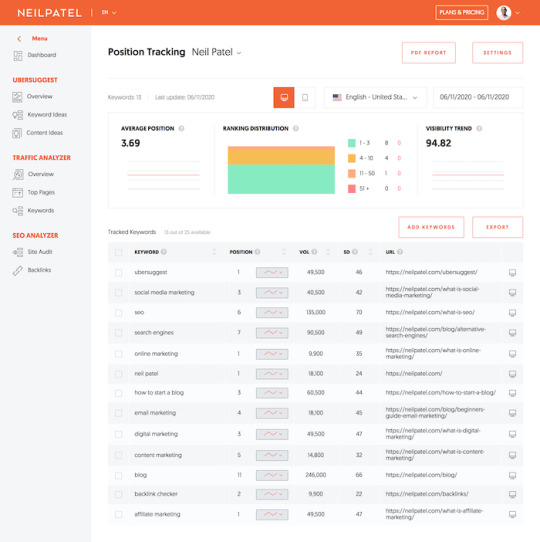
With so many things going on in marketing, you don’t have time to manually check your rankings or if things are going up or down or even what you need to fix.
Ubersuggest will do it for you all automatically and even notify you of what needs to happen through email. That way you don’t have to constantly check your SEO. Ubersuggest will do it all automatically.
More so, you’ll get notified of what you need to focus on each week to maximize your traffic.
All you have do is head to the dashboard and click on “Add Your First Project.”
It’s as simple as adding in your URL.

Then select the locations you do business in and want traffic from.
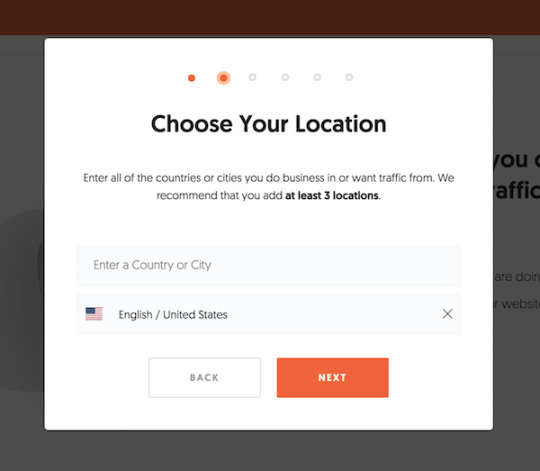
Then add in the keywords you currently rank for or want to go after.

And of course, set up your traffic preferences.
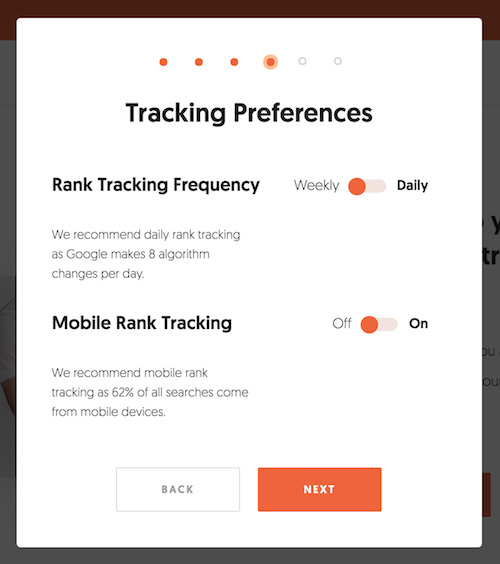
And then you’ll be good to go.
Then when things go great, you’ll be notified. And when things are going wrong, you’ll also be notified. Ubersuggest will even tell you what to fix.
That way you get the maximum results in the least amount of time.
Tool #2: Google Analytics Alerts
You have Google Analytics set up on your site, but how often do you log in?
And when you do log in, do you know what to focus on or what to look at?
And if you do, do you know what to do with that data?
Google Analytics is a great tool, but you don’t want to waste hours and hours looking at reports. Instead, you want to spend your time doing and getting results.
But if you set up alerts in Google Analytics, you can save tons of time.
If you watch from the 6:33 mark, it will show you how to set up alerts. I added the whole video as it will teach you how to set up Google Analytics in general in case you don’t have goal tracking set it place.
Once you set up alerts, you’ll again get notified when anything good or bad happens. I usually have alerts set up for only when things go bad, so I know when I need to focus on fixing my marketing.
Tool #3: Trello
You’re probably thinking how the heck is Trello a marketing tool. It really isn’t, but it is a good project management tool.
And with your SEO, you may have a team helping you out and Trello will help streamline the process, make you more efficient, and get your results faster.

I keep my Trello board simple by breaking it into 3 sections.
To do – what needs to be done over time.
Prioritized – what I need to be done now (tasks at the top are the most important)
Done – tasks that need to be double-checked to ensure they were done right.
It’s that simple. That way you don’t have to micromanage your team.
Some people have more complex Trello boards, but something simple like I have worked too.
If you want to create a Trello board for your content marketing, assuming you want to write lots of content (such as 10 posts a week), this process works well.
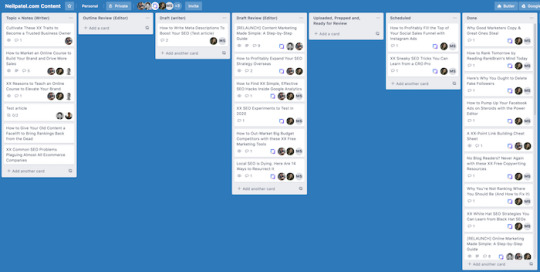
The columns I use for content writers are:
Topics – this is where writers add topics they want to write about.
Outline review – writers submit their outline before they write for approval.
Draft – writers submit their rough draft.
Draft review – editors review each draft.
Uploaded, prepared, and ready to review – this is where the editor adds the post to your CMS (like WordPress).
Scheduled – this is where you schedule the content to go live.
Done – the content is now live.
We’ve found it effective if you are managing dozens of writers at once.
Tool #4: Content Decay Tool
Can you guess how many articles I write each week?
1.
Seriously, that’s it. 1 article a week which is roughly 4 to 5 per month (depending on how many weeks in the month).
And can you guess how many articles my team and I update each week?
21.
That’s roughly 90 a month.
Just think about it… why would I have a team of 3 people updating 90 articles per month when I only write 1 a week.
It’s because updating old content is an easier way to get more SEO traffic than it is to create new content.
But what content should you update?
The content decay tool will tell you that.
It breaks down in order which articles you should update first, second, third… based on what will generate you the most traffic.
If you are wondering what is involved with updating content, just think of it this way:
Is there anything outdated within your post – if so, either update the outdated information and make it relevant again. If you can’t, then delete that part from your article.
Can you use media to improve the experience – do you need to embed videos, add more pictures, maybe even add an infographic? Use media to better tell your story and message.
Are you including the right keywords – a simple way to get more traffic is to integrate other popular related keywords within your article. Whatever your article is about, insert it into Ubersuggest and head to the “Keyword Ideas” report in the left-hand navigation.
Is there anything missing – try to poke holes within your content. What could you have done to make it better? What do your competitors talk about that you forgot to mention? What questions didn’t you answer that the reader might have? By asking yourself these simple questions, you’ll be able to make it better.
Tool #5: Ubersuggest Chrome Extension
If you haven’t installed the Ubersuggest Chrome extension, make sure you do so.
I’m not going to bore you with all of the features of the extension… instead, I am going to give you one thing that will save you time.
You know when you Google for information to learn more on any subject?
Chances are, sometimes you are Googling to learn something related to your space. And when you do, you’ll find that your site usually won’t be at the top of those search results.
And that’s ok.
But when you do a search, you’ll notice “monthly searches” in the Google search bar.

This shows you how often that keyword is searched.
So anytime you are looking up anything in your space, pay attention to that number. If you see a keyword with over 5,000 searches, it may be worth targeting.
And as you scroll down and start going through the sites that rank at the top, you’ll notice metrics under each site.
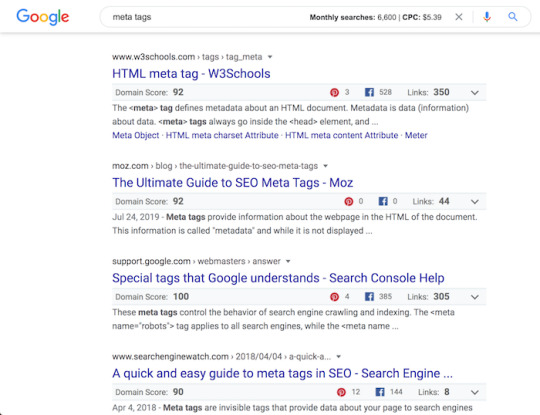
If you notice a web page with thousands of social shares and hundreds of links, it should reaffirm that you probably want to go after that term. And the listing that has thousands of social shares and hundreds of links is a good benchmark of a page that is high in quality and what people in your space prefer.
Ideally, you want to create something better than that one, as that is the main way you beat them over time.
Tool #6: Hello Bar
SEO is very different than paid traffic.
With paid traffic, you can drive people to a landing page with very little content, which makes it easier to generate sales or leads.
With SEO, Google prefers to rank content-rich sites.
But when someone lands on a page full of educational-based content, they are less likely to convert into a customer.
There’s a simple fix… Hello Bar.
Hello Bar has a lot of features, but I just want you to use the top bar like I do on NeilPatel.com.

And as you scroll it moves along with you.
That one little thing allows me to improve my conversion rate from my SEO traffic.
You can easily adjust what you show with a few simple clicks within Hello Bar or you can even show people different messages based on where they are coming from.

Although SEO traffic doesn’t convert as well as paid traffic, it is much cheaper in the long run and does have a better overall ROI. And that one little Hello Bar will improve your numbers.
It’s responsible for 9.4% of revenue from NeilPatel.com.
Every little bit adds up.
Tool #7: Mozcast
Google makes over 3,200 algorithm changes a year.
Are you really going to keep up to date with all of them?
If you followed the first tool and set up a project in Ubersuggest, you’ll get notified when your rankings go down.
And if you set up alerts in Google Analytics (tool number 2) you’ll also get notified when your traffic drops drastically.
What you’ll find is that it’s overwhelming to keep up with all of Google’s updates and it could be confusing to figure out what you need to fix to get your traffic back.
This report on Moz keeps track of all of the algorithm updates and gives you an overview of what has changed or what the update is about. On top of that, you’ll want to check out the Mozcast if you get a notification of ranking or traffic drops as this tool confirms if other people are also seeing changes from a Google update.

Keep in mind that Google doesn’t announce each update, hence you’ll want to cross-reference what you are seeing with the Mozcast.
That way you don’t have to spend hours researching each update.
Tool #8: Detailed
Link building is a pain. There are so many link tools like this one… but let’s not kid ourselves… you just don’t have the time to spend 10 to 20 hours a week doing link building.
So, each minute you spend, you have to make sure it counts.
There’s a tool called Detailed that breaks down the best links for every industry.
All you have to do is select an industry and a site and it shows you all of the good links that are going to your competition.
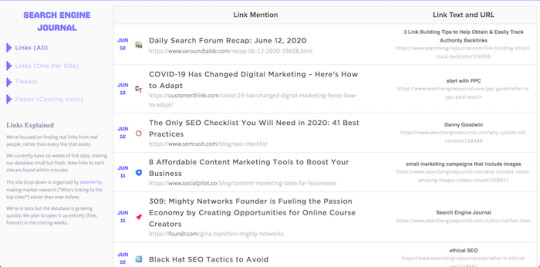
You can then focus your efforts on reaching out to those sites to get links.
Sure, you will still need to have amazing content or a good product or service in order to convince those sites to link to you, but hey, if you don’t have any of that it’s going to be hard to do well in the first place.
So, don’t waste your time trying to search for links when Detailed will give you a list of hundreds of amazing sites to get links from within your space.
Tool #9: Site Speed Audit
Speed impacts rankings.
Google doesn’t want to rank slow websites anymore.
It doesn’t matter that technology has become better and you can now purchase satellite Internet. Not every location has blazing fast Internet.
For that reason, Google has an Accelerated Mobile Pages framework that helps with mobile load time.
But that’s not enough, you also need your website to load fast.
So, go here and put in your URL.
You’ll then be taken to a report that looks like this:
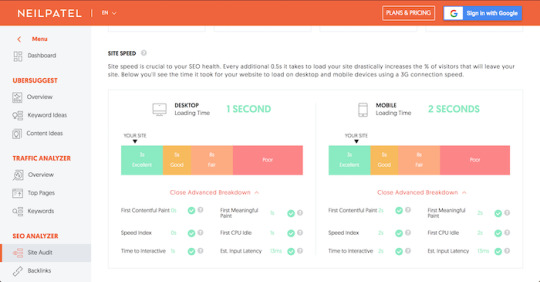
What’ll you want to focus on is site speed. That Ubersuggest report pulls from Google Lighthouse.
So, send that to your developer and tell them to get you in the green mark for both mobile and desktop load times.
As your speed goes up, so will your SEO rankings and traffic over time.
Tool #10: Supermetrics
Are you tired of having your data everywhere?
Why would you want to log into four of five different apps to get your SEO and marketing data when you could log into one.
And no, I am not talking about Google Analytics. I am talking about Google Data Studio.
If you haven’t used it yet, sign up for it… it’s free.

Google Data Studio is a business intelligence tool that will show you all of your data in one place.
So how do you get all of your SEO data into Google Data Studio? You use Supermetrics.
It passes all of your SEO data from different sources into Data Studio, so you no longer have to log into multiple tools, including Google Analytics.
My favorite feature in Supermetrics is you can automate your marketing reporting, so you no longer have to create your reports manually.
Tool #11: VidIQ
Google is the most popular search engine.
But do you know what the second most popular search engine is?
It’s not Bing… it’s actually YouTube, which Google actually owns.
If you haven’t done YouTube SEO yet, you should reconsider. Just look at how much search traffic I get from YouTube each month.
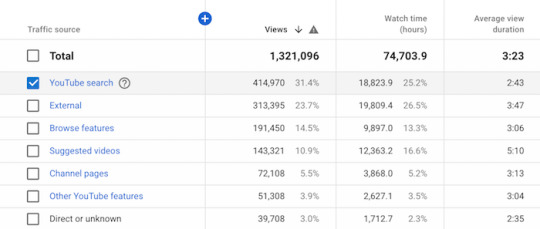
This article will break down how to do YouTube SEO if you want to learn how it works.
But to make things easier, install this Chrome extension.
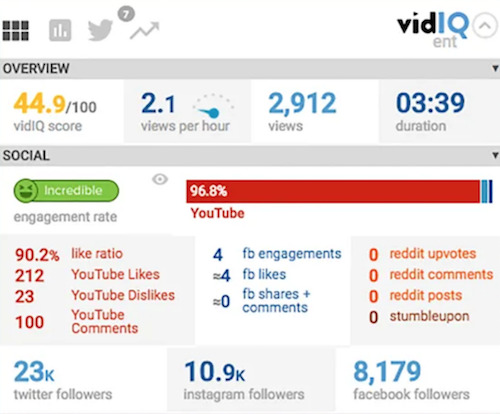
Whenever you perform a search on YouTube it will show you what’s popular, what keywords are being searched that are related to each video, and which tags people are using to get more SEO traffic.
I wanted to end this post with VidIQ because it’s not competitive.
See, unlike traditional SEO, it doesn’t take months to see results. YouTube SEO is the opposite in which it isn’t as competitive (yet) and you can rank at the top within 24 to 48 hours of releasing a video (seriously!).
Conclusion
They say SEO is hard and time-consuming. And I am not going to lie, you won’t get results unless you put in some effort.
But who says it has to be as time-consuming?
By using some of the tools I mentioned above you’ll save time. It really is that simple.
I know there is a lot and it can be overwhelming. So if you don’t have time to use all of the tools it is fine… just start at the top and work your way down (I put them in order based on what will save you the most time).
What other ways do you save time on your SEO?
The post The SEO Tool Kit: 11 Tools That’ll Save You Time appeared first on Neil Patel.
Original content source: https://neilpatel.com/blog/seo-tool-kit/ via https://neilpatel.com
See the original post, The SEO Tool Kit: 11 Tools Thatll Save You Time that is shared from https://imtrainingparadise.weebly.com/home/the-seo-tool-kit-11-tools-thatll-save-you-time via https://imtrainingparadise.weebly.com/home
0 notes
Text
The SEO Tool Kit: 11 Tools That’ll Save You Time

When I first got into the world of SEO, you could literally optimize your site for any term and rank at the top of Google within a month or two.
But of course, that was ages ago.
Now with Google’s ever-evolving algorithm, it takes more time and effort to get results.
But what happens if you don’t have the luxury of time? Or you don’t have the financial resources to put in the effort that is truly needed.
What should you do?
Just forget about SEO?
Of course not. Today, I want to call out 11 tools that will help you get an edge over your competition. But unlike most lists, I am going to get very specific on the feature I want you to use within each tool to make your life easier and help you get results faster with less effort.
Let’s dive right in.
Tool #1: Ubersuggest Projects
You probably already know about Ubersuggest, but do you really have time to spend hours and hours each week to do your SEO?
Chances are you don’t.
So how do you improve your traffic with the least amount of effort?
You set up a project in Ubersuggest.
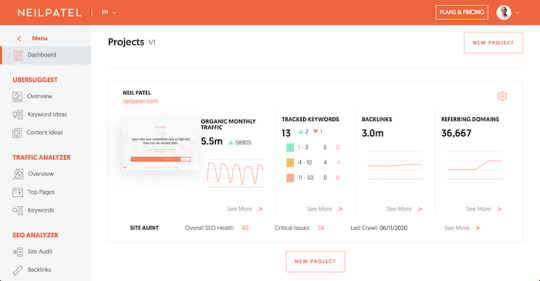
As you can see, it shows your SEO traffic over time. It will let you know if your rankings are going up or down, your link growth, and your SEO issues.
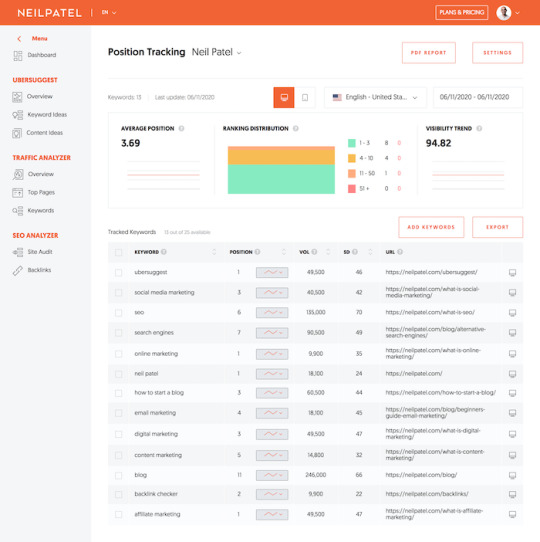
With so many things going on in marketing, you don’t have time to manually check your rankings or if things are going up or down or even what you need to fix.
Ubersuggest will do it for you all automatically and even notify you of what needs to happen through email. That way you don’t have to constantly check your SEO. Ubersuggest will do it all automatically.
More so, you’ll get notified of what you need to focus on each week to maximize your traffic.
All you have do is head to the dashboard and click on “Add Your First Project.”
It’s as simple as adding in your URL.
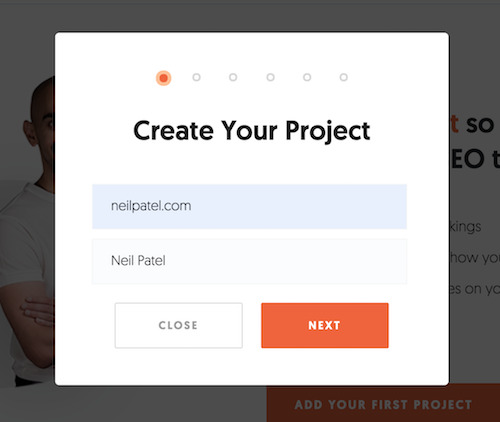
Then select the locations you do business in and want traffic from.

Then add in the keywords you currently rank for or want to go after.

And of course, set up your traffic preferences.
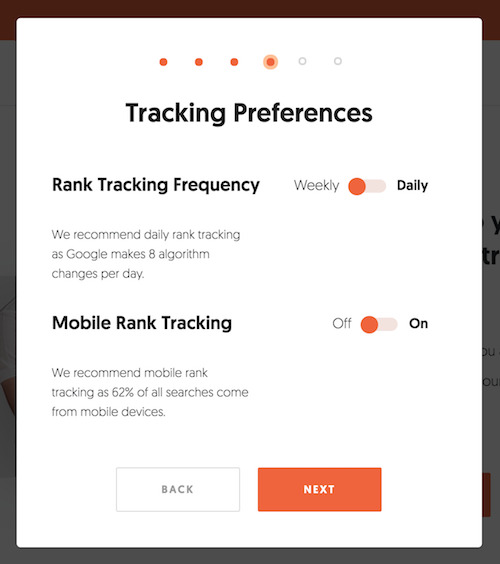
And then you’ll be good to go.
Then when things go great, you’ll be notified. And when things are going wrong, you’ll also be notified. Ubersuggest will even tell you what to fix.
That way you get the maximum results in the least amount of time.
Tool #2: Google Analytics Alerts
You have Google Analytics set up on your site, but how often do you log in?
And when you do log in, do you know what to focus on or what to look at?
And if you do, do you know what to do with that data?
Google Analytics is a great tool, but you don’t want to waste hours and hours looking at reports. Instead, you want to spend your time doing and getting results.
But if you set up alerts in Google Analytics, you can save tons of time.
youtube
If you watch from the 6:33 mark, it will show you how to set up alerts. I added the whole video as it will teach you how to set up Google Analytics in general in case you don’t have goal tracking set it place.
Once you set up alerts, you’ll again get notified when anything good or bad happens. I usually have alerts set up for only when things go bad, so I know when I need to focus on fixing my marketing.
Tool #3: Trello
You’re probably thinking how the heck is Trello a marketing tool. It really isn’t, but it is a good project management tool.
And with your SEO, you may have a team helping you out and Trello will help streamline the process, make you more efficient, and get your results faster.
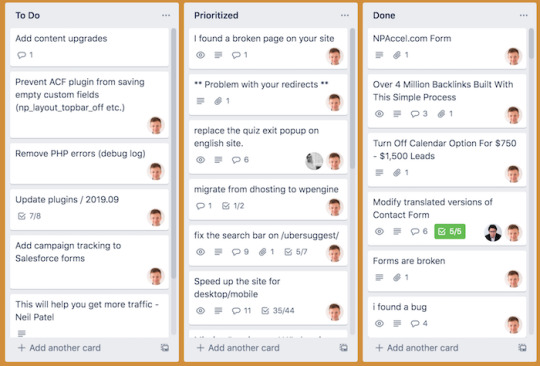
I keep my Trello board simple by breaking it into 3 sections.
To do – what needs to be done over time.
Prioritized – what I need to be done now (tasks at the top are the most important)
Done – tasks that need to be double-checked to ensure they were done right.
It’s that simple. That way you don’t have to micromanage your team.
Some people have more complex Trello boards, but something simple like I have worked too.
If you want to create a Trello board for your content marketing, assuming you want to write lots of content (such as 10 posts a week), this process works well.
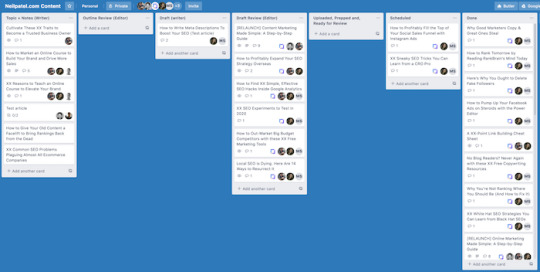
The columns I use for content writers are:
Topics – this is where writers add topics they want to write about.
Outline review – writers submit their outline before they write for approval.
Draft – writers submit their rough draft.
Draft review – editors review each draft.
Uploaded, prepared, and ready to review – this is where the editor adds the post to your CMS (like WordPress).
Scheduled – this is where you schedule the content to go live.
Done – the content is now live.
We’ve found it effective if you are managing dozens of writers at once.
Tool #4: Content Decay Tool
Can you guess how many articles I write each week?
1.
Seriously, that’s it. 1 article a week which is roughly 4 to 5 per month (depending on how many weeks in the month).
And can you guess how many articles my team and I update each week?
21.
That’s roughly 90 a month.
Just think about it… why would I have a team of 3 people updating 90 articles per month when I only write 1 a week.
It’s because updating old content is an easier way to get more SEO traffic than it is to create new content.
But what content should you update?
The content decay tool will tell you that.
youtube
It breaks down in order which articles you should update first, second, third… based on what will generate you the most traffic.
If you are wondering what is involved with updating content, just think of it this way:
Is there anything outdated within your post – if so, either update the outdated information and make it relevant again. If you can’t, then delete that part from your article.
Can you use media to improve the experience – do you need to embed videos, add more pictures, maybe even add an infographic? Use media to better tell your story and message.
Are you including the right keywords – a simple way to get more traffic is to integrate other popular related keywords within your article. Whatever your article is about, insert it into Ubersuggest and head to the “Keyword Ideas” report in the left-hand navigation.
Is there anything missing – try to poke holes within your content. What could you have done to make it better? What do your competitors talk about that you forgot to mention? What questions didn’t you answer that the reader might have? By asking yourself these simple questions, you’ll be able to make it better.
Tool #5: Ubersuggest Chrome Extension
If you haven’t installed the Ubersuggest Chrome extension, make sure you do so.
I’m not going to bore you with all of the features of the extension… instead, I am going to give you one thing that will save you time.
You know when you Google for information to learn more on any subject?
Chances are, sometimes you are Googling to learn something related to your space. And when you do, you’ll find that your site usually won’t be at the top of those search results.
And that’s ok.
But when you do a search, you’ll notice “monthly searches” in the Google search bar.

This shows you how often that keyword is searched.
So anytime you are looking up anything in your space, pay attention to that number. If you see a keyword with over 5,000 searches, it may be worth targeting.
And as you scroll down and start going through the sites that rank at the top, you’ll notice metrics under each site.

If you notice a web page with thousands of social shares and hundreds of links, it should reaffirm that you probably want to go after that term. And the listing that has thousands of social shares and hundreds of links is a good benchmark of a page that is high in quality and what people in your space prefer.
Ideally, you want to create something better than that one, as that is the main way you beat them over time.
Tool #6: Hello Bar
SEO is very different than paid traffic.
With paid traffic, you can drive people to a landing page with very little content, which makes it easier to generate sales or leads.
With SEO, Google prefers to rank content-rich sites.
But when someone lands on a page full of educational-based content, they are less likely to convert into a customer.
There’s a simple fix… Hello Bar.
Hello Bar has a lot of features, but I just want you to use the top bar like I do on NeilPatel.com.
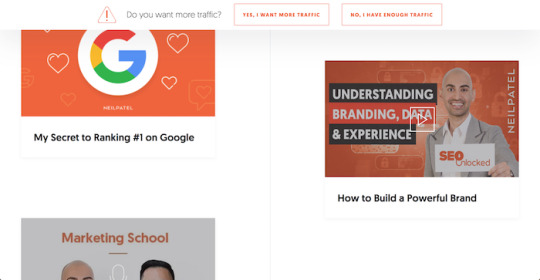
And as you scroll it moves along with you.
That one little thing allows me to improve my conversion rate from my SEO traffic.
You can easily adjust what you show with a few simple clicks within Hello Bar or you can even show people different messages based on where they are coming from.
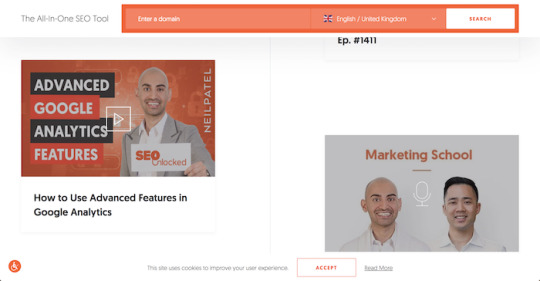
Although SEO traffic doesn’t convert as well as paid traffic, it is much cheaper in the long run and does have a better overall ROI. And that one little Hello Bar will improve your numbers.
It’s responsible for 9.4% of revenue from NeilPatel.com.
Every little bit adds up.
Tool #7: Mozcast
Google makes over 3,200 algorithm changes a year.
Are you really going to keep up to date with all of them?
If you followed the first tool and set up a project in Ubersuggest, you’ll get notified when your rankings go down.
And if you set up alerts in Google Analytics (tool number 2) you’ll also get notified when your traffic drops drastically.
What you’ll find is that it’s overwhelming to keep up with all of Google’s updates and it could be confusing to figure out what you need to fix to get your traffic back.
This report on Moz keeps track of all of the algorithm updates and gives you an overview of what has changed or what the update is about. On top of that, you’ll want to check out the Mozcast if you get a notification of ranking or traffic drops as this tool confirms if other people are also seeing changes from a Google update.
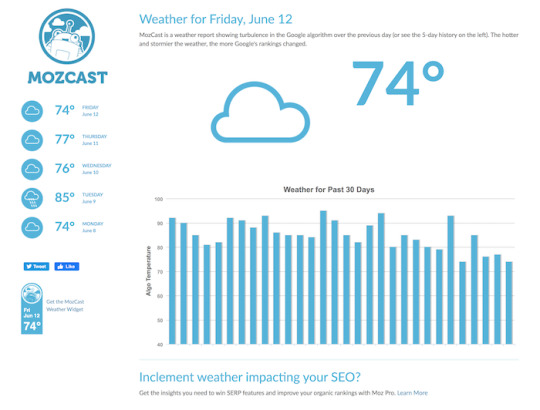
Keep in mind that Google doesn’t announce each update, hence you’ll want to cross-reference what you are seeing with the Mozcast.
That way you don’t have to spend hours researching each update.
Tool #8: Detailed
Link building is a pain. There are so many link tools like this one… but let’s not kid ourselves… you just don’t have the time to spend 10 to 20 hours a week doing link building.
So, each minute you spend, you have to make sure it counts.
There’s a tool called Detailed that breaks down the best links for every industry.
All you have to do is select an industry and a site and it shows you all of the good links that are going to your competition.
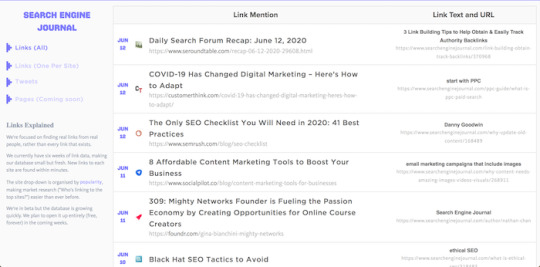
You can then focus your efforts on reaching out to those sites to get links.
Sure, you will still need to have amazing content or a good product or service in order to convince those sites to link to you, but hey, if you don’t have any of that it’s going to be hard to do well in the first place.
So, don’t waste your time trying to search for links when Detailed will give you a list of hundreds of amazing sites to get links from within your space.
Tool #9: Site Speed Audit
Speed impacts rankings.
Google doesn’t want to rank slow websites anymore.
It doesn’t matter that technology has become better and you can now purchase satellite Internet. Not every location has blazing fast Internet.
For that reason, Google has an Accelerated Mobile Pages framework that helps with mobile load time.
But that’s not enough, you also need your website to load fast.
So, go here and put in your URL.
You’ll then be taken to a report that looks like this:

What’ll you want to focus on is site speed. That Ubersuggest report pulls from Google Lighthouse.
So, send that to your developer and tell them to get you in the green mark for both mobile and desktop load times.
As your speed goes up, so will your SEO rankings and traffic over time.
Tool #10: Supermetrics
Are you tired of having your data everywhere?
Why would you want to log into four of five different apps to get your SEO and marketing data when you could log into one.
And no, I am not talking about Google Analytics. I am talking about Google Data Studio.
If you haven’t used it yet, sign up for it… it’s free.
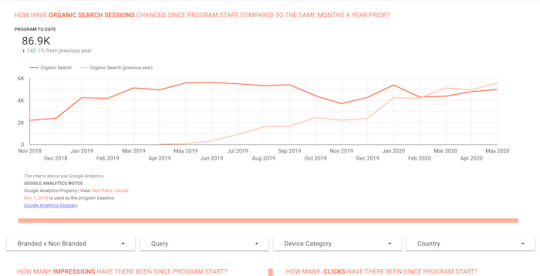
Google Data Studio is a business intelligence tool that will show you all of your data in one place.
So how do you get all of your SEO data into Google Data Studio? You use Supermetrics.
It passes all of your SEO data from different sources into Data Studio, so you no longer have to log into multiple tools, including Google Analytics.
My favorite feature in Supermetrics is you can automate your marketing reporting, so you no longer have to create your reports manually.
Tool #11: VidIQ
Google is the most popular search engine.
But do you know what the second most popular search engine is?
It’s not Bing… it’s actually YouTube, which Google actually owns.
If you haven’t done YouTube SEO yet, you should reconsider. Just look at how much search traffic I get from YouTube each month.

This article will break down how to do YouTube SEO if you want to learn how it works.
But to make things easier, install this Chrome extension.

Whenever you perform a search on YouTube it will show you what’s popular, what keywords are being searched that are related to each video, and which tags people are using to get more SEO traffic.
I wanted to end this post with VidIQ because it’s not competitive.
See, unlike traditional SEO, it doesn’t take months to see results. YouTube SEO is the opposite in which it isn’t as competitive (yet) and you can rank at the top within 24 to 48 hours of releasing a video (seriously!).
Conclusion
They say SEO is hard and time-consuming. And I am not going to lie, you won’t get results unless you put in some effort.
But who says it has to be as time-consuming?
By using some of the tools I mentioned above you’ll save time. It really is that simple.
I know there is a lot and it can be overwhelming. So if you don’t have time to use all of the tools it is fine… just start at the top and work your way down (I put them in order based on what will save you the most time).
What other ways do you save time on your SEO?
The post The SEO Tool Kit: 11 Tools That’ll Save You Time appeared first on Neil Patel.
Original content source: https://ift.tt/2YAJL0G via https://neilpatel.com The post, The SEO Tool Kit: 11 Tools That’ll Save You Time, has been shared from https://ift.tt/2ULC7zh via https://ift.tt/2r0Go64
0 notes
Text
The SEO Tool Kit: 11 Tools That’ll Save You Time
email marketing list providers
When I first got into the world of SEO, you could literally optimize your site for any term and rank at the top of Google within a month or two.
But of course, that was ages ago.
Now with Google’s ever-evolving algorithm, it takes more time and effort to get results.
But what happens if you don’t have the luxury of time? Or you don’t have the financial resources to put in the effort that is truly needed.
What should you do?
Just forget about SEO?
Of course not. Today, I want to call out 11 tools that will help you get an edge over your competition. But unlike most lists, I am going to get very specific on the feature I want you to use within each tool to make your life easier and help you get results faster with less effort.
Let’s dive right in.
Tool #1: Ubersuggest Projects
You probably already know about Ubersuggest, but do you really have time to spend hours and hours each week to do your SEO?
Chances are you don’t.
So how do you improve your traffic with the least amount of effort?
You set up a project in Ubersuggest.
As you can see, it shows your SEO traffic over time. It will let you know if your rankings are going up or down, your link growth, and your SEO issues.
With so many things going on in marketing, you don’t have time to manually check your rankings or if things are going up or down or even what you need to fix.
Ubersuggest will do it for you all automatically and even notify you of what needs to happen through email. That way you don’t have to constantly check your SEO. Ubersuggest will do it all automatically.
More so, you’ll get notified of what you need to focus on each week to maximize your traffic.
All you have do is head to the dashboard and click on “Add Your First Project.”
It’s as simple as adding in your URL.
Then select the locations you do business in and want traffic from.
Then add in the keywords you currently rank for or want to go after.
And of course, set up your traffic preferences.
And then you’ll be good to go.
Then when things go great, you’ll be notified. And when things are going wrong, you’ll also be notified. Ubersuggest will even tell you what to fix.
That way you get the maximum results in the least amount of time.
Tool #2: Google Analytics Alerts
You have Google Analytics set up on your site, but how often do you log in?
And when you do log in, do you know what to focus on or what to look at?
And if you do, do you know what to do with that data?
Google Analytics is a great tool, but you don’t want to waste hours and hours looking at reports. Instead, you want to spend your time doing and getting results.
But if you set up alerts in Google Analytics, you can save tons of time.
youtube
If you watch from the 6:33 mark, it will show you how to set up alerts. I added the whole video as it will teach you how to set up Google Analytics in general in case you don’t have goal tracking set it place.
Once you set up alerts, you’ll again get notified when anything good or bad happens. I usually have alerts set up for only when things go bad, so I know when I need to focus on fixing my marketing.
Tool #3: Trello
You’re probably thinking how the heck is Trello a marketing tool. It really isn’t, but it is a good project management tool.
And with your SEO, you may have a team helping you out and Trello will help streamline the process, make you more efficient, and get your results faster.
I keep my Trello board simple by breaking it into 3 sections.
To do – what needs to be done over time.
Prioritized – what I need to be done now (tasks at the top are the most important)
Done – tasks that need to be double-checked to ensure they were done right.
It’s that simple. That way you don’t have to micromanage your team.
Some people have more complex Trello boards, but something simple like I have worked too.
If you want to create a Trello board for your content marketing, assuming you want to write lots of content (such as 10 posts a week), this process works well.
The columns I use for content writers are:
Topics – this is where writers add topics they want to write about.
Outline review – writers submit their outline before they write for approval.
Draft – writers submit their rough draft.
Draft review – editors review each draft.
Uploaded, prepared, and ready to review – this is where the editor adds the post to your CMS (like WordPress).
Scheduled – this is where you schedule the content to go live.
Done – the content is now live.
We’ve found it effective if you are managing dozens of writers at once.
Tool #4: Content Decay Tool
Can you guess how many articles I write each week?
1.
Seriously, that’s it. 1 article a week which is roughly 4 to 5 per month (depending on how many weeks in the month).
And can you guess how many articles my team and I update each week?
21.
That’s roughly 90 a month.
Just think about it… why would I have a team of 3 people updating 90 articles per month when I only write 1 a week.
It’s because updating old content is an easier way to get more SEO traffic than it is to create new content.
But what content should you update?
The content decay tool will tell you that.
youtube
It breaks down in order which articles you should update first, second, third… based on what will generate you the most traffic.
If you are wondering what is involved with updating content, just think of it this way:
Is there anything outdated within your post – if so, either update the outdated information and make it relevant again. If you can’t, then delete that part from your article.
Can you use media to improve the experience – do you need to embed videos, add more pictures, maybe even add an infographic? Use media to better tell your story and message.
Are you including the right keywords – a simple way to get more traffic is to integrate other popular related keywords within your article. Whatever your article is about, insert it into Ubersuggest and head to the “Keyword Ideas” report in the left-hand navigation.
Is there anything missing – try to poke holes within your content. What could you have done to make it better? What do your competitors talk about that you forgot to mention? What questions didn’t you answer that the reader might have? By asking yourself these simple questions, you’ll be able to make it better.
Tool #5: Ubersuggest Chrome Extension
If you haven’t installed the Ubersuggest Chrome extension, make sure you do so.
I’m not going to bore you with all of the features of the extension… instead, I am going to give you one thing that will save you time.
You know when you Google for information to learn more on any subject?
Chances are, sometimes you are Googling to learn something related to your space. And when you do, you’ll find that your site usually won’t be at the top of those search results.
And that’s ok.
But when you do a search, you’ll notice “monthly searches” in the Google search bar.
This shows you how often that keyword is searched.
So anytime you are looking up anything in your space, pay attention to that number. If you see a keyword with over 5,000 searches, it may be worth targeting.
And as you scroll down and start going through the sites that rank at the top, you’ll notice metrics under each site.
If you notice a web page with thousands of social shares and hundreds of links, it should reaffirm that you probably want to go after that term. And the listing that has thousands of social shares and hundreds of links is a good benchmark of a page that is high in quality and what people in your space prefer.
Ideally, you want to create something better than that one, as that is the main way you beat them over time.
Tool #6: Hello Bar
SEO is very different than paid traffic.
With paid traffic, you can drive people to a landing page with very little content, which makes it easier to generate sales or leads.
With SEO, Google prefers to rank content-rich sites.
But when someone lands on a page full of educational-based content, they are less likely to convert into a customer.
There’s a simple fix… Hello Bar.
Hello Bar has a lot of features, but I just want you to use the top bar like I do on NeilPatel.com.
And as you scroll it moves along with you.
That one little thing allows me to improve my conversion rate from my SEO traffic.
You can easily adjust what you show with a few simple clicks within Hello Bar or you can even show people different messages based on where they are coming from.
Although SEO traffic doesn’t convert as well as paid traffic, it is much cheaper in the long run and does have a better overall ROI. And that one little Hello Bar will improve your numbers.
It’s responsible for 9.4% of revenue from NeilPatel.com.
Every little bit adds up.
Tool #7: Mozcast
Google makes over 3,200 algorithm changes a year.
Are you really going to keep up to date with all of them?
If you followed the first tool and set up a project in Ubersuggest, you’ll get notified when your rankings go down.
And if you set up alerts in Google Analytics (tool number 2) you’ll also get notified when your traffic drops drastically.
What you’ll find is that it’s overwhelming to keep up with all of Google’s updates and it could be confusing to figure out what you need to fix to get your traffic back.
This report on Moz keeps track of all of the algorithm updates and gives you an overview of what has changed or what the update is about. On top of that, you’ll want to check out the Mozcast if you get a notification of ranking or traffic drops as this tool confirms if other people are also seeing changes from a Google update.
Keep in mind that Google doesn’t announce each update, hence you’ll want to cross-reference what you are seeing with the Mozcast.
That way you don’t have to spend hours researching each update.
Tool #8: Detailed
Link building is a pain. There are so many link tools like this one… but let’s not kid ourselves… you just don’t have the time to spend 10 to 20 hours a week doing link building.
So, each minute you spend, you have to make sure it counts.
There’s a tool called Detailed that breaks down the best links for every industry.
All you have to do is select an industry and a site and it shows you all of the good links that are going to your competition.
You can then focus your efforts on reaching out to those sites to get links.
Sure, you will still need to have amazing content or a good product or service in order to convince those sites to link to you, but hey, if you don’t have any of that it’s going to be hard to do well in the first place.
So, don’t waste your time trying to search for links when Detailed will give you a list of hundreds of amazing sites to get links from within your space.
Tool #9: Site Speed Audit
Speed impacts rankings.
Google doesn’t want to rank slow websites anymore.
It doesn’t matter that technology has become better and you can now purchase satellite Internet. Not every location has blazing fast Internet.
For that reason, Google has an Accelerated Mobile Pages framework that helps with mobile load time.
But that’s not enough, you also need your website to load fast.
So, go here and put in your URL.
You’ll then be taken to a report that looks like this:
What’ll you want to focus on is site speed. That Ubersuggest report pulls from Google Lighthouse.
So, send that to your developer and tell them to get you in the green mark for both mobile and desktop load times.
As your speed goes up, so will your SEO rankings and traffic over time.
Tool #10: Supermetrics
Are you tired of having your data everywhere?
Why would you want to log into four of five different apps to get your SEO and marketing data when you could log into one.
And no, I am not talking about Google Analytics. I am talking about Google Data Studio.
If you haven’t used it yet, sign up for it… it’s free.
Google Data Studio is a business intelligence tool that will show you all of your data in one place.
So how do you get all of your SEO data into Google Data Studio? You use Supermetrics.
It passes all of your SEO data from different sources into Data Studio, so you no longer have to log into multiple tools, including Google Analytics.
My favorite feature in Supermetrics is you can automate your marketing reporting, so you no longer have to create your reports manually.
Tool #11: VidIQ
Google is the most popular search engine.
But do you know what the second most popular search engine is?
It’s not Bing… it’s actually YouTube, which Google actually owns.
If you haven’t done YouTube SEO yet, you should reconsider. Just look at how much search traffic I get from YouTube each month.
This article will break down how to do YouTube SEO if you want to learn how it works.
But to make things easier, install this Chrome extension.
Whenever you perform a search on YouTube it will show you what’s popular, what keywords are being searched that are related to each video, and which tags people are using to get more SEO traffic.
I wanted to end this post with VidIQ because it’s not competitive.
See, unlike traditional SEO, it doesn’t take months to see results. YouTube SEO is the opposite in which it isn’t as competitive (yet) and you can rank at the top within 24 to 48 hours of releasing a video (seriously!).
Conclusion
They say SEO is hard and time-consuming. And I am not going to lie, you won’t get results unless you put in some effort.
But who says it has to be as time-consuming?
By using some of the tools I mentioned above you’ll save time. It really is that simple.
I know there is a lot and it can be overwhelming. So if you don’t have time to use all of the tools it is fine… just start at the top and work your way down (I put them in order based on what will save you the most time).
What other ways do you save time on your SEO?
Google
0 notes
Text
The SEO Tool Kit: 11 Tools That’ll Save You Time
When I first got into the world of SEO, you could literally optimize your site for any term and rank at the top of Google within a month or two.
But of course, that was ages ago.
Now with Google’s ever-evolving algorithm, it takes more time and effort to get results.
But what happens if you don’t have the luxury of time? Or you don’t have the financial resources to put in the effort that is truly needed.
What should you do?
Just forget about SEO?
Of course not. Today, I want to call out 11 tools that will help you get an edge over your competition. But unlike most lists, I am going to get very specific on the feature I want you to use within each tool to make your life easier and help you get results faster with less effort.
Let’s dive right in.
Tool #1: Ubersuggest Projects
You probably already know about Ubersuggest, but do you really have time to spend hours and hours each week to do your SEO?
Chances are you don’t.
So how do you improve your traffic with the least amount of effort?
You set up a project in Ubersuggest.
As you can see, it shows your SEO traffic over time. It will let you know if your rankings are going up or down, your link growth, and your SEO issues.
With so many things going on in marketing, you don’t have time to manually check your rankings or if things are going up or down or even what you need to fix.
Ubersuggest will do it for you all automatically and even notify you of what needs to happen through email. That way you don’t have to constantly check your SEO. Ubersuggest will do it all automatically.
More so, you’ll get notified of what you need to focus on each week to maximize your traffic.
All you have do is head to the dashboard and click on “Add Your First Project.”
It’s as simple as adding in your URL.
Then select the locations you do business in and want traffic from.
Then add in the keywords you currently rank for or want to go after.
And of course, set up your traffic preferences.
And then you’ll be good to go.
Then when things go great, you’ll be notified. And when things are going wrong, you’ll also be notified. Ubersuggest will even tell you what to fix.
That way you get the maximum results in the least amount of time.
Tool #2: Google Analytics Alerts
You have Google Analytics set up on your site, but how often do you log in?
And when you do log in, do you know what to focus on or what to look at?
And if you do, do you know what to do with that data?
Google Analytics is a great tool, but you don’t want to waste hours and hours looking at reports. Instead, you want to spend your time doing and getting results.
But if you set up alerts in Google Analytics, you can save tons of time.
youtube
If you watch from the 6:33 mark, it will show you how to set up alerts. I added the whole video as it will teach you how to set up Google Analytics in general in case you don’t have goal tracking set it place.
Once you set up alerts, you’ll again get notified when anything good or bad happens. I usually have alerts set up for only when things go bad, so I know when I need to focus on fixing my marketing.
Tool #3: Trello
You’re probably thinking how the heck is Trello a marketing tool. It really isn’t, but it is a good project management tool.
And with your SEO, you may have a team helping you out and Trello will help streamline the process, make you more efficient, and get your results faster.
I keep my Trello board simple by breaking it into 3 sections.
To do – what needs to be done over time.
Prioritized – what I need to be done now (tasks at the top are the most important)
Done – tasks that need to be double-checked to ensure they were done right.
It’s that simple. That way you don’t have to micromanage your team.
Some people have more complex Trello boards, but something simple like I have worked too.
If you want to create a Trello board for your content marketing, assuming you want to write lots of content (such as 10 posts a week), this process works well.
The columns I use for content writers are:
Topics – this is where writers add topics they want to write about.
Outline review – writers submit their outline before they write for approval.
Draft – writers submit their rough draft.
Draft review – editors review each draft.
Uploaded, prepared, and ready to review – this is where the editor adds the post to your CMS (like WordPress).
Scheduled – this is where you schedule the content to go live.
Done – the content is now live.
We’ve found it effective if you are managing dozens of writers at once.
Tool #4: Content Decay Tool
Can you guess how many articles I write each week?
1.
Seriously, that’s it. 1 article a week which is roughly 4 to 5 per month (depending on how many weeks in the month).
And can you guess how many articles my team and I update each week?
21.
That’s roughly 90 a month.
Just think about it… why would I have a team of 3 people updating 90 articles per month when I only write 1 a week.
It’s because updating old content is an easier way to get more SEO traffic than it is to create new content.
But what content should you update?
The content decay tool will tell you that.
youtube
It breaks down in order which articles you should update first, second, third… based on what will generate you the most traffic.
If you are wondering what is involved with updating content, just think of it this way:
Is there anything outdated within your post – if so, either update the outdated information and make it relevant again. If you can’t, then delete that part from your article.
Can you use media to improve the experience – do you need to embed videos, add more pictures, maybe even add an infographic? Use media to better tell your story and message.
Are you including the right keywords – a simple way to get more traffic is to integrate other popular related keywords within your article. Whatever your article is about, insert it into Ubersuggest and head to the “Keyword Ideas” report in the left-hand navigation.
Is there anything missing – try to poke holes within your content. What could you have done to make it better? What do your competitors talk about that you forgot to mention? What questions didn’t you answer that the reader might have? By asking yourself these simple questions, you’ll be able to make it better.
Tool #5: Ubersuggest Chrome Extension
If you haven’t installed the Ubersuggest Chrome extension, make sure you do so.
I’m not going to bore you with all of the features of the extension… instead, I am going to give you one thing that will save you time.
You know when you Google for information to learn more on any subject?
Chances are, sometimes you are Googling to learn something related to your space. And when you do, you’ll find that your site usually won’t be at the top of those search results.
And that’s ok.
But when you do a search, you’ll notice “monthly searches” in the Google search bar.
This shows you how often that keyword is searched.
So anytime you are looking up anything in your space, pay attention to that number. If you see a keyword with over 5,000 searches, it may be worth targeting.
And as you scroll down and start going through the sites that rank at the top, you’ll notice metrics under each site.
If you notice a web page with thousands of social shares and hundreds of links, it should reaffirm that you probably want to go after that term. And the listing that has thousands of social shares and hundreds of links is a good benchmark of a page that is high in quality and what people in your space prefer.
Ideally, you want to create something better than that one, as that is the main way you beat them over time.
Tool #6: Hello Bar
SEO is very different than paid traffic.
With paid traffic, you can drive people to a landing page with very little content, which makes it easier to generate sales or leads.
With SEO, Google prefers to rank content-rich sites.
But when someone lands on a page full of educational-based content, they are less likely to convert into a customer.
There’s a simple fix… Hello Bar.
Hello Bar has a lot of features, but I just want you to use the top bar like I do on NeilPatel.com.
And as you scroll it moves along with you.
That one little thing allows me to improve my conversion rate from my SEO traffic.
You can easily adjust what you show with a few simple clicks within Hello Bar or you can even show people different messages based on where they are coming from.
Although SEO traffic doesn’t convert as well as paid traffic, it is much cheaper in the long run and does have a better overall ROI. And that one little Hello Bar will improve your numbers.
It’s responsible for 9.4% of revenue from NeilPatel.com.
Every little bit adds up.
Tool #7: Mozcast
Google makes over 3,200 algorithm changes a year.
Are you really going to keep up to date with all of them?
If you followed the first tool and set up a project in Ubersuggest, you’ll get notified when your rankings go down.
And if you set up alerts in Google Analytics (tool number 2) you’ll also get notified when your traffic drops drastically.
What you’ll find is that it’s overwhelming to keep up with all of Google’s updates and it could be confusing to figure out what you need to fix to get your traffic back.
This report on Moz keeps track of all of the algorithm updates and gives you an overview of what has changed or what the update is about. On top of that, you’ll want to check out the Mozcast if you get a notification of ranking or traffic drops as this tool confirms if other people are also seeing changes from a Google update.
Keep in mind that Google doesn’t announce each update, hence you’ll want to cross-reference what you are seeing with the Mozcast.
That way you don’t have to spend hours researching each update.
Tool #8: Detailed
Link building is a pain. There are so many link tools like this one… but let’s not kid ourselves… you just don’t have the time to spend 10 to 20 hours a week doing link building.
So, each minute you spend, you have to make sure it counts.
There’s a tool called Detailed that breaks down the best links for every industry.
All you have to do is select an industry and a site and it shows you all of the good links that are going to your competition.
You can then focus your efforts on reaching out to those sites to get links.
Sure, you will still need to have amazing content or a good product or service in order to convince those sites to link to you, but hey, if you don’t have any of that it’s going to be hard to do well in the first place.
So, don’t waste your time trying to search for links when Detailed will give you a list of hundreds of amazing sites to get links from within your space.
Tool #9: Site Speed Audit
Speed impacts rankings.
Google doesn’t want to rank slow websites anymore.
It doesn’t matter that technology has become better and you can now purchase satellite Internet. Not every location has blazing fast Internet.
For that reason, Google has an Accelerated Mobile Pages framework that helps with mobile load time.
But that’s not enough, you also need your website to load fast.
So, go here and put in your URL.
You’ll then be taken to a report that looks like this:
What’ll you want to focus on is site speed. That Ubersuggest report pulls from Google Lighthouse.
So, send that to your developer and tell them to get you in the green mark for both mobile and desktop load times.
As your speed goes up, so will your SEO rankings and traffic over time.
Tool #10: Supermetrics
Are you tired of having your data everywhere?
Why would you want to log into four of five different apps to get your SEO and marketing data when you could log into one.
And no, I am not talking about Google Analytics. I am talking about Google Data Studio.
If you haven’t used it yet, sign up for it… it’s free.
Google Data Studio is a business intelligence tool that will show you all of your data in one place.
So how do you get all of your SEO data into Google Data Studio? You use Supermetrics.
It passes all of your SEO data from different sources into Data Studio, so you no longer have to log into multiple tools, including Google Analytics.
My favorite feature in Supermetrics is you can automate your marketing reporting, so you no longer have to create your reports manually.
Tool #11: VidIQ
Google is the most popular search engine.
But do you know what the second most popular search engine is?
It’s not Bing… it’s actually YouTube, which Google actually owns.
If you haven’t done YouTube SEO yet, you should reconsider. Just look at how much search traffic I get from YouTube each month.
This article will break down how to do YouTube SEO if you want to learn how it works.
But to make things easier, install this Chrome extension.
Whenever you perform a search on YouTube it will show you what’s popular, what keywords are being searched that are related to each video, and which tags people are using to get more SEO traffic.
I wanted to end this post with VidIQ because it’s not competitive.
See, unlike traditional SEO, it doesn’t take months to see results. YouTube SEO is the opposite in which it isn’t as competitive (yet) and you can rank at the top within 24 to 48 hours of releasing a video (seriously!).
Conclusion
They say SEO is hard and time-consuming. And I am not going to lie, you won’t get results unless you put in some effort.
But who says it has to be as time-consuming?
By using some of the tools I mentioned above you’ll save time. It really is that simple.
I know there is a lot and it can be overwhelming. So if you don’t have time to use all of the tools it is fine… just start at the top and work your way down (I put them in order based on what will save you the most time).
What other ways do you save time on your SEO?
The post The SEO Tool Kit: 11 Tools That’ll Save You Time appeared first on Neil Patel.
0 notes
Text
Why and How to Bring Empathy Into Your Content
Posted by DaisyQ
Creating content can feel incredibly difficult right now. If you’re like me, you’ve spent the last few weeks oscillating between a can-do approach and hours of staring into space. Here’s how to tap into those very real emotions and channel them into more impactful content.
What empathy is and isn’t
We commonly confuse sympathy with empathy. Sympathy is understanding and perhaps feeling bad for the struggles that someone may be experiencing. Empathy means understanding the person’s feelings and thoughts from their point of view. Sympathy is when you feel compassion, sorrow, or pity for what the other person is going through. Empathy is about putting yourself in their shoes.
In this post, I focus on cognitive empathy, which is the ability to understand how another person may be thinking or feeling. Cognitive empathy helps communication by helping us convey information in a way that resonates with the other person.
Feelings, who needs ’em?
I’ve always struggled with how to deal with my emotions. For much of my life, I thought that I needed to keep how I felt under wraps, especially at work. I recall tough days when I Googled reasons to get out of bed, and when I reached my desk, I would try to leave my emotions at home and just focus on working. Sometimes, the office felt like an escape. But usually, pretending to be unfeeling was a difficult if not impossible task. When this strategy backfires, our feelings overrule us. I’ve come to embrace the fact that emotions are what make me whole and human.
There’s a lot going on, and we’re all grappling with it
Creating marketing content can be incredibly hard right now because there is just so much going on — not only in your mind but in your readers’ minds, too. Rather than shy away from the current emotional challenge, embrace it to transform your work and get more joy out of the content creation process.
People are looking for information, and depending on your industry, there may be several content opportunities for you to dig into. Or maybe you are in an industry where it’s business as (un)usual, and you have to create email newsletters or blog content like you always have.
Whether you sell industrial components to obscure parts of machines or homemade broths, there’s room in your content for empathy. For example, are you creating a blog post on how to work from home? Think about the parent who’s never had to juggle homeschooling their kids while holding conference calls. Are you writing about cyber threats and the need to protect firmware? Think about how the risk of a cyberattack is the last thing a dispersed IT team wants to deal with right now.
Your readers are all grappling with different issues. The ability to convey empathy in your writing will make your work much more captivating, impactful, shareable, and just plain better — whether we’re dealing with a pandemic or not.
Do I have to pretend to be a mom now?
No, you don’t. In fact, pretending can come off as disingenuous. You are not required to have the same lived-in experiences or circumstances that your reader does. Instead, just try to understand their perspective.
See if you can tell the difference between these messages:
“Chin up! It’s hard, but I’m sure it will get better.”
“I know everything looks bleak right now, but you will get through this.”
While there is nothing wrong with the first sentence in the above example, the second sentence comes across as more caring and compassionate.
Done well, empathizing can make it easier to understand the challenges, frustrations, fears, anxieties, or worries your readers might be experiencing.
How to infuse content marketing with empathy
Empathy is a skill. Those who master it gain the ability to create content that not only addresses a surface problem or issue, but also hits a deeper level by accessing the perspectives and emotions involved.
Picture the person reading
Want your readers to take action? Try to understand them.
Take your health, for example. Pretty much any advice given by your doctor would be critical, right? Yet we often struggle to implement it. Why is that? One reason could be empathy. Studies show that better health outcomes result when a physician shows empathy towards their patient.
Are you trying to incite action with your post? Maybe you want your readers to do more than just read your blog and carry on with their lives, then seek to understand where they are coming from first. Whether you’re creating a blog post or a video, picture the person who will read or watch what you are sharing, and speak directly to them. Better yet, find an image of someone that represents your intended audience online and pull it up while creating. Make your audience real. In turn, your content will become more productive because a reader who feels understood is more likely to apply what they read.
This tactic works for me when I have to create a how-to video or break something down. I pick an image from the web and ask, “Would they get it?”
Set a goal for your content
Creating content can be a slog. Setting an intention is one of my favorite ways to give purpose to my process. It helps me push through the mornings when I don’t care about finishing that first draft. I like to think about where I want to take the audience, then revisit that goal again and again until the project is complete.
For example, the goal of this blog post is:
To help business owners and marketers who need to send out emails or write blog posts while we’re dealing with a pandemic. It’s not business as usual, and empathy is what we need now more than ever. I will share why empathy works, and give practical tips on how writing in a more relatable, humane, and approachable way can help get the point across.
When I start a new post, I print a paragraph like this right at the top of my word doc. I revisit it multiple times while I’m writing and reviewing the draft. Then, I delete it right before I submit the post. Moment of truth: Does the post stand on its own? Does it express what I need to say? If so, I know it’s ready.
Share personal stories or anecdotes
I read a story by Leo Tolstoy recently that really stuck with me— in fact, the ending haunted me for a while. It was a story about greed titled, “How Much Land Does a Man Need?”
Tolstoy could have written an essay on how greed is wrong, but I probably wouldn’t have remembered it. Instead, I can vividly recall the farmer who dies during the struggle to get one more foot of land even though he has more than enough already.
Personal stories give meaning to your work, and you don’t need to travel to a Russian prairie to find examples. There is material in your everyday life that you can put onto paper. Think of childhood memories, past events, relationships — heck, your favorite passage from a book. How can you weave these into your narrative in a way that will connect with the reader? How can you share a tidbit from your personal life that will pull your readers in?
The ultimate question is: Who’s your audience? Once you know that, you’ll know what to share.
If you have to write about budgeting tips, put yourself in your reader’s shoes. Think back to a time when you had to watch where every dollar went. How did you cope? What resources did you use? Relate that to what your reader’s budget struggles may be today. How can your experiences help you empathize with a mom in a single-income household who now has to file for unemployment? Or the business owner who needs to re-shuffle a budget and maybe cut ancillary services? You don’t have to be in their position to appreciate what they are going through.
Think less self-promotional and more educational
Have you ever gotten to the end of a blog post and wondered why you bothered reading at all? That writer probably made an impression on you, and it wasn’t great.
Reward the reader by giving them something actionable. Help them achieve a goal they have, or include something worth retelling that’ll impress their boss, friends, or spouse. Look beyond what you’re immediately selling and appreciate how it relates to the bigger picture. Even an external hard drive or a peppercorn grinder can take on new meaning when you look at it from this perspective.
Perhaps that external hard drive is not just gigabytes but a way to digitize a family album to share with distant relatives. Or for the budding YouTuber, it may be a way to store all their outtakes without slowing down their computer. Show them how they can get more storage space or pick the best product for their needs. How can they use your advice to live their best life?
Learn from the masters
Put down the business book and try fiction.
As marketers, we can get stuck in a cycle of reading marketing content. I have at least 12 books that I could (and should) be reading instead of a Hemingway classic. But reading non-marketing materials will improve your empathetic skills by demonstrating how storytelling works.
I’m halfway through “A Farewell to Arms”, and I think the point of the story is that wars are long and pointless. I could be wrong, but I haven’t stopped reading it yet. That’s the key — the narrative is carrying me along. I’m invested in the characters and their endings. I want to find out what happens to Catherine Barkley because I empathize with her.
If you want to kick it up a notch, learn from works like Stephen King’s “On Writing” or Joseph Campbell’s “The Hero with a Thousand Faces”. These classics pinpoint principles of narrative that work consistently across time and space. They’re as relevant and essential as ever, and they can inform, strengthen, and enliven your content. Bonus: maybe they’ll inspire you to write that novel someday.
Creating content with empathy helps you and your readers
Really good content makes us feel something. It’s a feeling that sticks with us long, long after the words have escaped our minds. That’s the kind of impression you can leave in your readers’ minds, but not without getting to know where they are coming from. Simply stating numbers and stats and figures won’t cut it. We don’t operate in a vacuum. Our relationships with people, our shared experiences, and our connections are what drive us, and in times like this, that doesn’t change. Let it be the glue that helps you bond with your audience.
Sign up for The Moz Top 10, a semimonthly mailer updating you on the top ten hottest pieces of SEO news, tips, and rad links uncovered by the Moz team. Think of it as your exclusive digest of stuff you don't have time to hunt down but want to read!
via Blogger https://ift.tt/2JNYjD5 #blogger #bloggingtips #bloggerlife #bloggersgetsocial #ontheblog #writersofinstagram #writingprompt #instapoetry #writerscommunity #writersofig #writersblock #writerlife #writtenword #instawriters #spilledink #wordgasm #creativewriting #poetsofinstagram #blackoutpoetry #poetsofig
0 notes
Text
Why and How to Bring Empathy Into Your Content
Posted by DaisyQ
Creating content can feel incredibly difficult right now. If you’re like me, you’ve spent the last few weeks oscillating between a can-do approach and hours of staring into space. Here’s how to tap into those very real emotions and channel them into more impactful content.
What empathy is and isn’t
We commonly confuse sympathy with empathy. Sympathy is understanding and perhaps feeling bad for the struggles that someone may be experiencing. Empathy means understanding the person’s feelings and thoughts from their point of view. Sympathy is when you feel compassion, sorrow, or pity for what the other person is going through. Empathy is about putting yourself in their shoes.
In this post, I focus on cognitive empathy, which is the ability to understand how another person may be thinking or feeling. Cognitive empathy helps communication by helping us convey information in a way that resonates with the other person.
Feelings, who needs ’em?
I’ve always struggled with how to deal with my emotions. For much of my life, I thought that I needed to keep how I felt under wraps, especially at work. I recall tough days when I Googled reasons to get out of bed, and when I reached my desk, I would try to leave my emotions at home and just focus on working. Sometimes, the office felt like an escape. But usually, pretending to be unfeeling was a difficult if not impossible task. When this strategy backfires, our feelings overrule us. I’ve come to embrace the fact that emotions are what make me whole and human.
There’s a lot going on, and we’re all grappling with it
Creating marketing content can be incredibly hard right now because there is just so much going on — not only in your mind but in your readers’ minds, too. Rather than shy away from the current emotional challenge, embrace it to transform your work and get more joy out of the content creation process.
People are looking for information, and depending on your industry, there may be several content opportunities for you to dig into. Or maybe you are in an industry where it’s business as (un)usual, and you have to create email newsletters or blog content like you always have.
Whether you sell industrial components to obscure parts of machines or homemade broths, there’s room in your content for empathy. For example, are you creating a blog post on how to work from home? Think about the parent who’s never had to juggle homeschooling their kids while holding conference calls. Are you writing about cyber threats and the need to protect firmware? Think about how the risk of a cyberattack is the last thing a dispersed IT team wants to deal with right now.
Your readers are all grappling with different issues. The ability to convey empathy in your writing will make your work much more captivating, impactful, shareable, and just plain better — whether we’re dealing with a pandemic or not.
Do I have to pretend to be a mom now?
No, you don’t. In fact, pretending can come off as disingenuous. You are not required to have the same lived-in experiences or circumstances that your reader does. Instead, just try to understand their perspective.
See if you can tell the difference between these messages:
“Chin up! It’s hard, but I’m sure it will get better.”
“I know everything looks bleak right now, but you will get through this.”
While there is nothing wrong with the first sentence in the above example, the second sentence comes across as more caring and compassionate.
Done well, empathizing can make it easier to understand the challenges, frustrations, fears, anxieties, or worries your readers might be experiencing.
How to infuse content marketing with empathy
Empathy is a skill. Those who master it gain the ability to create content that not only addresses a surface problem or issue, but also hits a deeper level by accessing the perspectives and emotions involved.
Picture the person reading
Want your readers to take action? Try to understand them.
Take your health, for example. Pretty much any advice given by your doctor would be critical, right? Yet we often struggle to implement it. Why is that? One reason could be empathy. Studies show that better health outcomes result when a physician shows empathy towards their patient.
Are you trying to incite action with your post? Maybe you want your readers to do more than just read your blog and carry on with their lives, then seek to understand where they are coming from first. Whether you’re creating a blog post or a video, picture the person who will read or watch what you are sharing, and speak directly to them. Better yet, find an image of someone that represents your intended audience online and pull it up while creating. Make your audience real. In turn, your content will become more productive because a reader who feels understood is more likely to apply what they read.
This tactic works for me when I have to create a how-to video or break something down. I pick an image from the web and ask, “Would they get it?”
Set a goal for your content
Creating content can be a slog. Setting an intention is one of my favorite ways to give purpose to my process. It helps me push through the mornings when I don’t care about finishing that first draft. I like to think about where I want to take the audience, then revisit that goal again and again until the project is complete.
For example, the goal of this blog post is:
To help business owners and marketers who need to send out emails or write blog posts while we’re dealing with a pandemic. It’s not business as usual, and empathy is what we need now more than ever. I will share why empathy works, and give practical tips on how writing in a more relatable, humane, and approachable way can help get the point across.
When I start a new post, I print a paragraph like this right at the top of my word doc. I revisit it multiple times while I’m writing and reviewing the draft. Then, I delete it right before I submit the post. Moment of truth: Does the post stand on its own? Does it express what I need to say? If so, I know it’s ready.
Share personal stories or anecdotes
I read a story by Leo Tolstoy recently that really stuck with me— in fact, the ending haunted me for a while. It was a story about greed titled, “How Much Land Does a Man Need?”
Tolstoy could have written an essay on how greed is wrong, but I probably wouldn’t have remembered it. Instead, I can vividly recall the farmer who dies during the struggle to get one more foot of land even though he has more than enough already.
Personal stories give meaning to your work, and you don’t need to travel to a Russian prairie to find examples. There is material in your everyday life that you can put onto paper. Think of childhood memories, past events, relationships — heck, your favorite passage from a book. How can you weave these into your narrative in a way that will connect with the reader? How can you share a tidbit from your personal life that will pull your readers in?
The ultimate question is: Who’s your audience? Once you know that, you’ll know what to share.
If you have to write about budgeting tips, put yourself in your reader’s shoes. Think back to a time when you had to watch where every dollar went. How did you cope? What resources did you use? Relate that to what your reader’s budget struggles may be today. How can your experiences help you empathize with a mom in a single-income household who now has to file for unemployment? Or the business owner who needs to re-shuffle a budget and maybe cut ancillary services? You don’t have to be in their position to appreciate what they are going through.
Think less self-promotional and more educational
Have you ever gotten to the end of a blog post and wondered why you bothered reading at all? That writer probably made an impression on you, and it wasn’t great.
Reward the reader by giving them something actionable. Help them achieve a goal they have, or include something worth retelling that’ll impress their boss, friends, or spouse. Look beyond what you’re immediately selling and appreciate how it relates to the bigger picture. Even an external hard drive or a peppercorn grinder can take on new meaning when you look at it from this perspective.
Perhaps that external hard drive is not just gigabytes but a way to digitize a family album to share with distant relatives. Or for the budding YouTuber, it may be a way to store all their outtakes without slowing down their computer. Show them how they can get more storage space or pick the best product for their needs. How can they use your advice to live their best life?
Learn from the masters
Put down the business book and try fiction.
As marketers, we can get stuck in a cycle of reading marketing content. I have at least 12 books that I could (and should) be reading instead of a Hemingway classic. But reading non-marketing materials will improve your empathetic skills by demonstrating how storytelling works.
I’m halfway through “A Farewell to Arms”, and I think the point of the story is that wars are long and pointless. I could be wrong, but I haven’t stopped reading it yet. That’s the key — the narrative is carrying me along. I’m invested in the characters and their endings. I want to find out what happens to Catherine Barkley because I empathize with her.
If you want to kick it up a notch, learn from works like Stephen King’s “On Writing” or Joseph Campbell’s “The Hero with a Thousand Faces”. These classics pinpoint principles of narrative that work consistently across time and space. They’re as relevant and essential as ever, and they can inform, strengthen, and enliven your content. Bonus: maybe they’ll inspire you to write that novel someday.
Creating content with empathy helps you and your readers
Really good content makes us feel something. It’s a feeling that sticks with us long, long after the words have escaped our minds. That’s the kind of impression you can leave in your readers’ minds, but not without getting to know where they are coming from. Simply stating numbers and stats and figures won’t cut it. We don’t operate in a vacuum. Our relationships with people, our shared experiences, and our connections are what drive us, and in times like this, that doesn’t change. Let it be the glue that helps you bond with your audience.
Sign up for The Moz Top 10, a semimonthly mailer updating you on the top ten hottest pieces of SEO news, tips, and rad links uncovered by the Moz team. Think of it as your exclusive digest of stuff you don't have time to hunt down but want to read!
from The Moz Blog http://tracking.feedpress.it/link/9375/13430490
0 notes
Text
Why and How to Bring Empathy Into Your Content
Posted by DaisyQ
Creating content can feel incredibly difficult right now. If you’re like me, you’ve spent the last few weeks oscillating between a can-do approach and hours of staring into space. Here’s how to tap into those very real emotions and channel them into more impactful content.
What empathy is and isn’t
We commonly confuse sympathy with empathy. Sympathy is understanding and perhaps feeling bad for the struggles that someone may be experiencing. Empathy means understanding the person’s feelings and thoughts from their point of view. Sympathy is when you feel compassion, sorrow, or pity for what the other person is going through. Empathy is about putting yourself in their shoes.
In this post, I focus on cognitive empathy, which is the ability to understand how another person may be thinking or feeling. Cognitive empathy helps communication by helping us convey information in a way that resonates with the other person.
Feelings, who needs ’em?
I’ve always struggled with how to deal with my emotions. For much of my life, I thought that I needed to keep how I felt under wraps, especially at work. I recall tough days when I Googled reasons to get out of bed, and when I reached my desk, I would try to leave my emotions at home and just focus on working. Sometimes, the office felt like an escape. But usually, pretending to be unfeeling was a difficult if not impossible task. When this strategy backfires, our feelings overrule us. I’ve come to embrace the fact that emotions are what make me whole and human.
There’s a lot going on, and we’re all grappling with it
Creating marketing content can be incredibly hard right now because there is just so much going on — not only in your mind but in your readers’ minds, too. Rather than shy away from the current emotional challenge, embrace it to transform your work and get more joy out of the content creation process.
People are looking for information, and depending on your industry, there may be several content opportunities for you to dig into. Or maybe you are in an industry where it’s business as (un)usual, and you have to create email newsletters or blog content like you always have.
Whether you sell industrial components to obscure parts of machines or homemade broths, there’s room in your content for empathy. For example, are you creating a blog post on how to work from home? Think about the parent who’s never had to juggle homeschooling their kids while holding conference calls. Are you writing about cyber threats and the need to protect firmware? Think about how the risk of a cyberattack is the last thing a dispersed IT team wants to deal with right now.
Your readers are all grappling with different issues. The ability to convey empathy in your writing will make your work much more captivating, impactful, shareable, and just plain better — whether we’re dealing with a pandemic or not.
Do I have to pretend to be a mom now?
No, you don’t. In fact, pretending can come off as disingenuous. You are not required to have the same lived-in experiences or circumstances that your reader does. Instead, just try to understand their perspective.
See if you can tell the difference between these messages:
“Chin up! It’s hard, but I’m sure it will get better.”
“I know everything looks bleak right now, but you will get through this.”
While there is nothing wrong with the first sentence in the above example, the second sentence comes across as more caring and compassionate.
Done well, empathizing can make it easier to understand the challenges, frustrations, fears, anxieties, or worries your readers might be experiencing.
How to infuse content marketing with empathy
Empathy is a skill. Those who master it gain the ability to create content that not only addresses a surface problem or issue, but also hits a deeper level by accessing the perspectives and emotions involved.
Picture the person reading
Want your readers to take action? Try to understand them.
Take your health, for example. Pretty much any advice given by your doctor would be critical, right? Yet we often struggle to implement it. Why is that? One reason could be empathy. Studies show that better health outcomes result when a physician shows empathy towards their patient.
Are you trying to incite action with your post? Maybe you want your readers to do more than just read your blog and carry on with their lives, then seek to understand where they are coming from first. Whether you’re creating a blog post or a video, picture the person who will read or watch what you are sharing, and speak directly to them. Better yet, find an image of someone that represents your intended audience online and pull it up while creating. Make your audience real. In turn, your content will become more productive because a reader who feels understood is more likely to apply what they read.
This tactic works for me when I have to create a how-to video or break something down. I pick an image from the web and ask, “Would they get it?”
Set a goal for your content
Creating content can be a slog. Setting an intention is one of my favorite ways to give purpose to my process. It helps me push through the mornings when I don’t care about finishing that first draft. I like to think about where I want to take the audience, then revisit that goal again and again until the project is complete.
For example, the goal of this blog post is:
To help business owners and marketers who need to send out emails or write blog posts while we’re dealing with a pandemic. It’s not business as usual, and empathy is what we need now more than ever. I will share why empathy works, and give practical tips on how writing in a more relatable, humane, and approachable way can help get the point across.
When I start a new post, I print a paragraph like this right at the top of my word doc. I revisit it multiple times while I’m writing and reviewing the draft. Then, I delete it right before I submit the post. Moment of truth: Does the post stand on its own? Does it express what I need to say? If so, I know it’s ready.
Share personal stories or anecdotes
I read a story by Leo Tolstoy recently that really stuck with me— in fact, the ending haunted me for a while. It was a story about greed titled, “How Much Land Does a Man Need?”
Tolstoy could have written an essay on how greed is wrong, but I probably wouldn’t have remembered it. Instead, I can vividly recall the farmer who dies during the struggle to get one more foot of land even though he has more than enough already.
Personal stories give meaning to your work, and you don’t need to travel to a Russian prairie to find examples. There is material in your everyday life that you can put onto paper. Think of childhood memories, past events, relationships — heck, your favorite passage from a book. How can you weave these into your narrative in a way that will connect with the reader? How can you share a tidbit from your personal life that will pull your readers in?
The ultimate question is: Who’s your audience? Once you know that, you’ll know what to share.
If you have to write about budgeting tips, put yourself in your reader’s shoes. Think back to a time when you had to watch where every dollar went. How did you cope? What resources did you use? Relate that to what your reader’s budget struggles may be today. How can your experiences help you empathize with a mom in a single-income household who now has to file for unemployment? Or the business owner who needs to re-shuffle a budget and maybe cut ancillary services? You don’t have to be in their position to appreciate what they are going through.
Think less self-promotional and more educational
Have you ever gotten to the end of a blog post and wondered why you bothered reading at all? That writer probably made an impression on you, and it wasn’t great.
Reward the reader by giving them something actionable. Help them achieve a goal they have, or include something worth retelling that’ll impress their boss, friends, or spouse. Look beyond what you’re immediately selling and appreciate how it relates to the bigger picture. Even an external hard drive or a peppercorn grinder can take on new meaning when you look at it from this perspective.
Perhaps that external hard drive is not just gigabytes but a way to digitize a family album to share with distant relatives. Or for the budding YouTuber, it may be a way to store all their outtakes without slowing down their computer. Show them how they can get more storage space or pick the best product for their needs. How can they use your advice to live their best life?
Learn from the masters
Put down the business book and try fiction.
As marketers, we can get stuck in a cycle of reading marketing content. I have at least 12 books that I could (and should) be reading instead of a Hemingway classic. But reading non-marketing materials will improve your empathetic skills by demonstrating how storytelling works.
I’m halfway through “A Farewell to Arms”, and I think the point of the story is that wars are long and pointless. I could be wrong, but I haven’t stopped reading it yet. That’s the key — the narrative is carrying me along. I’m invested in the characters and their endings. I want to find out what happens to Catherine Barkley because I empathize with her.
If you want to kick it up a notch, learn from works like Stephen King’s “On Writing” or Joseph Campbell’s “The Hero with a Thousand Faces”. These classics pinpoint principles of narrative that work consistently across time and space. They’re as relevant and essential as ever, and they can inform, strengthen, and enliven your content. Bonus: maybe they’ll inspire you to write that novel someday.
Creating content with empathy helps you and your readers
Really good content makes us feel something. It’s a feeling that sticks with us long, long after the words have escaped our minds. That’s the kind of impression you can leave in your readers’ minds, but not without getting to know where they are coming from. Simply stating numbers and stats and figures won’t cut it. We don’t operate in a vacuum. Our relationships with people, our shared experiences, and our connections are what drive us, and in times like this, that doesn’t change. Let it be the glue that helps you bond with your audience.
Sign up for The Moz Top 10, a semimonthly mailer updating you on the top ten hottest pieces of SEO news, tips, and rad links uncovered by the Moz team. Think of it as your exclusive digest of stuff you don't have time to hunt down but want to read!
from The Moz Blog https://ift.tt/2XlpPjk via IFTTT
0 notes
Text
Why and How to Bring Empathy Into Your Content
Posted by DaisyQ
Creating content can feel incredibly difficult right now. If you’re like me, you’ve spent the last few weeks oscillating between a can-do approach and hours of staring into space. Here’s how to tap into those very real emotions and channel them into more impactful content.
What empathy is and isn’t
We commonly confuse sympathy with empathy. Sympathy is understanding and perhaps feeling bad for the struggles that someone may be experiencing. Empathy means understanding the person’s feelings and thoughts from their point of view. Sympathy is when you feel compassion, sorrow, or pity for what the other person is going through. Empathy is about putting yourself in their shoes.
In this post, I focus on cognitive empathy, which is the ability to understand how another person may be thinking or feeling. Cognitive empathy helps communication by helping us convey information in a way that resonates with the other person.
Feelings, who needs ’em?
I’ve always struggled with how to deal with my emotions. For much of my life, I thought that I needed to keep how I felt under wraps, especially at work. I recall tough days when I Googled reasons to get out of bed, and when I reached my desk, I would try to leave my emotions at home and just focus on working. Sometimes, the office felt like an escape. But usually, pretending to be unfeeling was a difficult if not impossible task. When this strategy backfires, our feelings overrule us. I’ve come to embrace the fact that emotions are what make me whole and human.
There’s a lot going on, and we’re all grappling with it
Creating marketing content can be incredibly hard right now because there is just so much going on — not only in your mind but in your readers’ minds, too. Rather than shy away from the current emotional challenge, embrace it to transform your work and get more joy out of the content creation process.
People are looking for information, and depending on your industry, there may be several content opportunities for you to dig into. Or maybe you are in an industry where it’s business as (un)usual, and you have to create email newsletters or blog content like you always have.
Whether you sell industrial components to obscure parts of machines or homemade broths, there’s room in your content for empathy. For example, are you creating a blog post on how to work from home? Think about the parent who’s never had to juggle homeschooling their kids while holding conference calls. Are you writing about cyber threats and the need to protect firmware? Think about how the risk of a cyberattack is the last thing a dispersed IT team wants to deal with right now.
Your readers are all grappling with different issues. The ability to convey empathy in your writing will make your work much more captivating, impactful, shareable, and just plain better — whether we’re dealing with a pandemic or not.
Do I have to pretend to be a mom now?
No, you don’t. In fact, pretending can come off as disingenuous. You are not required to have the same lived-in experiences or circumstances that your reader does. Instead, just try to understand their perspective.
See if you can tell the difference between these messages:
“Chin up! It’s hard, but I’m sure it will get better.”
“I know everything looks bleak right now, but you will get through this.”
While there is nothing wrong with the first sentence in the above example, the second sentence comes across as more caring and compassionate.
Done well, empathizing can make it easier to understand the challenges, frustrations, fears, anxieties, or worries your readers might be experiencing.
How to infuse content marketing with empathy
Empathy is a skill. Those who master it gain the ability to create content that not only addresses a surface problem or issue, but also hits a deeper level by accessing the perspectives and emotions involved.
Picture the person reading
Want your readers to take action? Try to understand them.
Take your health, for example. Pretty much any advice given by your doctor would be critical, right? Yet we often struggle to implement it. Why is that? One reason could be empathy. Studies show that better health outcomes result when a physician shows empathy towards their patient.
Are you trying to incite action with your post? Maybe you want your readers to do more than just read your blog and carry on with their lives, then seek to understand where they are coming from first. Whether you’re creating a blog post or a video, picture the person who will read or watch what you are sharing, and speak directly to them. Better yet, find an image of someone that represents your intended audience online and pull it up while creating. Make your audience real. In turn, your content will become more productive because a reader who feels understood is more likely to apply what they read.
This tactic works for me when I have to create a how-to video or break something down. I pick an image from the web and ask, “Would they get it?”
Set a goal for your content
Creating content can be a slog. Setting an intention is one of my favorite ways to give purpose to my process. It helps me push through the mornings when I don’t care about finishing that first draft. I like to think about where I want to take the audience, then revisit that goal again and again until the project is complete.
For example, the goal of this blog post is:
To help business owners and marketers who need to send out emails or write blog posts while we’re dealing with a pandemic. It’s not business as usual, and empathy is what we need now more than ever. I will share why empathy works, and give practical tips on how writing in a more relatable, humane, and approachable way can help get the point across.
When I start a new post, I print a paragraph like this right at the top of my word doc. I revisit it multiple times while I’m writing and reviewing the draft. Then, I delete it right before I submit the post. Moment of truth: Does the post stand on its own? Does it express what I need to say? If so, I know it’s ready.
Share personal stories or anecdotes
I read a story by Leo Tolstoy recently that really stuck with me— in fact, the ending haunted me for a while. It was a story about greed titled, “How Much Land Does a Man Need?”
Tolstoy could have written an essay on how greed is wrong, but I probably wouldn’t have remembered it. Instead, I can vividly recall the farmer who dies during the struggle to get one more foot of land even though he has more than enough already.
Personal stories give meaning to your work, and you don’t need to travel to a Russian prairie to find examples. There is material in your everyday life that you can put onto paper. Think of childhood memories, past events, relationships — heck, your favorite passage from a book. How can you weave these into your narrative in a way that will connect with the reader? How can you share a tidbit from your personal life that will pull your readers in?
The ultimate question is: Who’s your audience? Once you know that, you’ll know what to share.
If you have to write about budgeting tips, put yourself in your reader’s shoes. Think back to a time when you had to watch where every dollar went. How did you cope? What resources did you use? Relate that to what your reader’s budget struggles may be today. How can your experiences help you empathize with a mom in a single-income household who now has to file for unemployment? Or the business owner who needs to re-shuffle a budget and maybe cut ancillary services? You don’t have to be in their position to appreciate what they are going through.
Think less self-promotional and more educational
Have you ever gotten to the end of a blog post and wondered why you bothered reading at all? That writer probably made an impression on you, and it wasn’t great.
Reward the reader by giving them something actionable. Help them achieve a goal they have, or include something worth retelling that’ll impress their boss, friends, or spouse. Look beyond what you’re immediately selling and appreciate how it relates to the bigger picture. Even an external hard drive or a peppercorn grinder can take on new meaning when you look at it from this perspective.
Perhaps that external hard drive is not just gigabytes but a way to digitize a family album to share with distant relatives. Or for the budding YouTuber, it may be a way to store all their outtakes without slowing down their computer. Show them how they can get more storage space or pick the best product for their needs. How can they use your advice to live their best life?
Learn from the masters
Put down the business book and try fiction.
As marketers, we can get stuck in a cycle of reading marketing content. I have at least 12 books that I could (and should) be reading instead of a Hemingway classic. But reading non-marketing materials will improve your empathetic skills by demonstrating how storytelling works.
I’m halfway through “A Farewell to Arms”, and I think the point of the story is that wars are long and pointless. I could be wrong, but I haven’t stopped reading it yet. That’s the key — the narrative is carrying me along. I’m invested in the characters and their endings. I want to find out what happens to Catherine Barkley because I empathize with her.
If you want to kick it up a notch, learn from works like Stephen King’s “On Writing” or Joseph Campbell’s “The Hero with a Thousand Faces”. These classics pinpoint principles of narrative that work consistently across time and space. They’re as relevant and essential as ever, and they can inform, strengthen, and enliven your content. Bonus: maybe they’ll inspire you to write that novel someday.
Creating content with empathy helps you and your readers
Really good content makes us feel something. It’s a feeling that sticks with us long, long after the words have escaped our minds. That’s the kind of impression you can leave in your readers’ minds, but not without getting to know where they are coming from. Simply stating numbers and stats and figures won’t cut it. We don’t operate in a vacuum. Our relationships with people, our shared experiences, and our connections are what drive us, and in times like this, that doesn’t change. Let it be the glue that helps you bond with your audience.
Sign up for The Moz Top 10, a semimonthly mailer updating you on the top ten hottest pieces of SEO news, tips, and rad links uncovered by the Moz team. Think of it as your exclusive digest of stuff you don't have time to hunt down but want to read!
0 notes
Text
Why and How to Bring Empathy Into Your Content
Posted by DaisyQ
Creating content can feel incredibly difficult right now. If you’re like me, you’ve spent the last few weeks oscillating between a can-do approach and hours of staring into space. Here’s how to tap into those very real emotions and channel them into more impactful content.
What empathy is and isn’t
We commonly confuse sympathy with empathy. Sympathy is understanding and perhaps feeling bad for the struggles that someone may be experiencing. Empathy means understanding the person’s feelings and thoughts from their point of view. Sympathy is when you feel compassion, sorrow, or pity for what the other person is going through. Empathy is about putting yourself in their shoes.
In this post, I focus on cognitive empathy, which is the ability to understand how another person may be thinking or feeling. Cognitive empathy helps communication by helping us convey information in a way that resonates with the other person.
Feelings, who needs ’em?
I’ve always struggled with how to deal with my emotions. For much of my life, I thought that I needed to keep how I felt under wraps, especially at work. I recall tough days when I Googled reasons to get out of bed, and when I reached my desk, I would try to leave my emotions at home and just focus on working. Sometimes, the office felt like an escape. But usually, pretending to be unfeeling was a difficult if not impossible task. When this strategy backfires, our feelings overrule us. I’ve come to embrace the fact that emotions are what make me whole and human.
There’s a lot going on, and we’re all grappling with it
Creating marketing content can be incredibly hard right now because there is just so much going on — not only in your mind but in your readers’ minds, too. Rather than shy away from the current emotional challenge, embrace it to transform your work and get more joy out of the content creation process.
People are looking for information, and depending on your industry, there may be several content opportunities for you to dig into. Or maybe you are in an industry where it’s business as (un)usual, and you have to create email newsletters or blog content like you always have.
Whether you sell industrial components to obscure parts of machines or homemade broths, there’s room in your content for empathy. For example, are you creating a blog post on how to work from home? Think about the parent who’s never had to juggle homeschooling their kids while holding conference calls. Are you writing about cyber threats and the need to protect firmware? Think about how the risk of a cyberattack is the last thing a dispersed IT team wants to deal with right now.
Your readers are all grappling with different issues. The ability to convey empathy in your writing will make your work much more captivating, impactful, shareable, and just plain better — whether we’re dealing with a pandemic or not.
Do I have to pretend to be a mom now?
No, you don’t. In fact, pretending can come off as disingenuous. You are not required to have the same lived-in experiences or circumstances that your reader does. Instead, just try to understand their perspective.
See if you can tell the difference between these messages:
“Chin up! It’s hard, but I’m sure it will get better.”
“I know everything looks bleak right now, but you will get through this.”
While there is nothing wrong with the first sentence in the above example, the second sentence comes across as more caring and compassionate.
Done well, empathizing can make it easier to understand the challenges, frustrations, fears, anxieties, or worries your readers might be experiencing.
How to infuse content marketing with empathy
Empathy is a skill. Those who master it gain the ability to create content that not only addresses a surface problem or issue, but also hits a deeper level by accessing the perspectives and emotions involved.
Picture the person reading
Want your readers to take action? Try to understand them.
Take your health, for example. Pretty much any advice given by your doctor would be critical, right? Yet we often struggle to implement it. Why is that? One reason could be empathy. Studies show that better health outcomes result when a physician shows empathy towards their patient.
Are you trying to incite action with your post? Maybe you want your readers to do more than just read your blog and carry on with their lives, then seek to understand where they are coming from first. Whether you’re creating a blog post or a video, picture the person who will read or watch what you are sharing, and speak directly to them. Better yet, find an image of someone that represents your intended audience online and pull it up while creating. Make your audience real. In turn, your content will become more productive because a reader who feels understood is more likely to apply what they read.
This tactic works for me when I have to create a how-to video or break something down. I pick an image from the web and ask, “Would they get it?”
Set a goal for your content
Creating content can be a slog. Setting an intention is one of my favorite ways to give purpose to my process. It helps me push through the mornings when I don’t care about finishing that first draft. I like to think about where I want to take the audience, then revisit that goal again and again until the project is complete.
For example, the goal of this blog post is:
To help business owners and marketers who need to send out emails or write blog posts while we’re dealing with a pandemic. It’s not business as usual, and empathy is what we need now more than ever. I will share why empathy works, and give practical tips on how writing in a more relatable, humane, and approachable way can help get the point across.
When I start a new post, I print a paragraph like this right at the top of my word doc. I revisit it multiple times while I’m writing and reviewing the draft. Then, I delete it right before I submit the post. Moment of truth: Does the post stand on its own? Does it express what I need to say? If so, I know it’s ready.
Share personal stories or anecdotes
I read a story by Leo Tolstoy recently that really stuck with me— in fact, the ending haunted me for a while. It was a story about greed titled, “How Much Land Does a Man Need?”
Tolstoy could have written an essay on how greed is wrong, but I probably wouldn’t have remembered it. Instead, I can vividly recall the farmer who dies during the struggle to get one more foot of land even though he has more than enough already.
Personal stories give meaning to your work, and you don’t need to travel to a Russian prairie to find examples. There is material in your everyday life that you can put onto paper. Think of childhood memories, past events, relationships — heck, your favorite passage from a book. How can you weave these into your narrative in a way that will connect with the reader? How can you share a tidbit from your personal life that will pull your readers in?
The ultimate question is: Who’s your audience? Once you know that, you’ll know what to share.
If you have to write about budgeting tips, put yourself in your reader’s shoes. Think back to a time when you had to watch where every dollar went. How did you cope? What resources did you use? Relate that to what your reader’s budget struggles may be today. How can your experiences help you empathize with a mom in a single-income household who now has to file for unemployment? Or the business owner who needs to re-shuffle a budget and maybe cut ancillary services? You don’t have to be in their position to appreciate what they are going through.
Think less self-promotional and more educational
Have you ever gotten to the end of a blog post and wondered why you bothered reading at all? That writer probably made an impression on you, and it wasn’t great.
Reward the reader by giving them something actionable. Help them achieve a goal they have, or include something worth retelling that’ll impress their boss, friends, or spouse. Look beyond what you’re immediately selling and appreciate how it relates to the bigger picture. Even an external hard drive or a peppercorn grinder can take on new meaning when you look at it from this perspective.
Perhaps that external hard drive is not just gigabytes but a way to digitize a family album to share with distant relatives. Or for the budding YouTuber, it may be a way to store all their outtakes without slowing down their computer. Show them how they can get more storage space or pick the best product for their needs. How can they use your advice to live their best life?
Learn from the masters
Put down the business book and try fiction.
As marketers, we can get stuck in a cycle of reading marketing content. I have at least 12 books that I could (and should) be reading instead of a Hemingway classic. But reading non-marketing materials will improve your empathetic skills by demonstrating how storytelling works.
I’m halfway through “A Farewell to Arms”, and I think the point of the story is that wars are long and pointless. I could be wrong, but I haven’t stopped reading it yet. That’s the key — the narrative is carrying me along. I’m invested in the characters and their endings. I want to find out what happens to Catherine Barkley because I empathize with her.
If you want to kick it up a notch, learn from works like Stephen King’s “On Writing” or Joseph Campbell’s “The Hero with a Thousand Faces”. These classics pinpoint principles of narrative that work consistently across time and space. They’re as relevant and essential as ever, and they can inform, strengthen, and enliven your content. Bonus: maybe they’ll inspire you to write that novel someday.
Creating content with empathy helps you and your readers
Really good content makes us feel something. It’s a feeling that sticks with us long, long after the words have escaped our minds. That’s the kind of impression you can leave in your readers’ minds, but not without getting to know where they are coming from. Simply stating numbers and stats and figures won’t cut it. We don’t operate in a vacuum. Our relationships with people, our shared experiences, and our connections are what drive us, and in times like this, that doesn’t change. Let it be the glue that helps you bond with your audience.
Sign up for The Moz Top 10, a semimonthly mailer updating you on the top ten hottest pieces of SEO news, tips, and rad links uncovered by the Moz team. Think of it as your exclusive digest of stuff you don't have time to hunt down but want to read!
0 notes
Text
Why and How to Bring Empathy Into Your Content
Posted by DaisyQ
Creating content can feel incredibly difficult right now. If you’re like me, you’ve spent the last few weeks oscillating between a can-do approach and hours of staring into space. Here’s how to tap into those very real emotions and channel them into more impactful content.
What empathy is and isn’t
We commonly confuse sympathy with empathy. Sympathy is understanding and perhaps feeling bad for the struggles that someone may be experiencing. Empathy means understanding the person’s feelings and thoughts from their point of view. Sympathy is when you feel compassion, sorrow, or pity for what the other person is going through. Empathy is about putting yourself in their shoes.
In this post, I focus on cognitive empathy, which is the ability to understand how another person may be thinking or feeling. Cognitive empathy helps communication by helping us convey information in a way that resonates with the other person.
Feelings, who needs ’em?
I’ve always struggled with how to deal with my emotions. For much of my life, I thought that I needed to keep how I felt under wraps, especially at work. I recall tough days when I Googled reasons to get out of bed, and when I reached my desk, I would try to leave my emotions at home and just focus on working. Sometimes, the office felt like an escape. But usually, pretending to be unfeeling was a difficult if not impossible task. When this strategy backfires, our feelings overrule us. I’ve come to embrace the fact that emotions are what make me whole and human.
There’s a lot going on, and we’re all grappling with it
Creating marketing content can be incredibly hard right now because there is just so much going on — not only in your mind but in your readers’ minds, too. Rather than shy away from the current emotional challenge, embrace it to transform your work and get more joy out of the content creation process.
People are looking for information, and depending on your industry, there may be several content opportunities for you to dig into. Or maybe you are in an industry where it’s business as (un)usual, and you have to create email newsletters or blog content like you always have.
Whether you sell industrial components to obscure parts of machines or homemade broths, there’s room in your content for empathy. For example, are you creating a blog post on how to work from home? Think about the parent who’s never had to juggle homeschooling their kids while holding conference calls. Are you writing about cyber threats and the need to protect firmware? Think about how the risk of a cyberattack is the last thing a dispersed IT team wants to deal with right now.
Your readers are all grappling with different issues. The ability to convey empathy in your writing will make your work much more captivating, impactful, shareable, and just plain better — whether we’re dealing with a pandemic or not.
Do I have to pretend to be a mom now?
No, you don’t. In fact, pretending can come off as disingenuous. You are not required to have the same lived-in experiences or circumstances that your reader does. Instead, just try to understand their perspective.
See if you can tell the difference between these messages:
“Chin up! It’s hard, but I’m sure it will get better.”
“I know everything looks bleak right now, but you will get through this.”
While there is nothing wrong with the first sentence in the above example, the second sentence comes across as more caring and compassionate.
Done well, empathizing can make it easier to understand the challenges, frustrations, fears, anxieties, or worries your readers might be experiencing.
How to infuse content marketing with empathy
Empathy is a skill. Those who master it gain the ability to create content that not only addresses a surface problem or issue, but also hits a deeper level by accessing the perspectives and emotions involved.
Picture the person reading
Want your readers to take action? Try to understand them.
Take your health, for example. Pretty much any advice given by your doctor would be critical, right? Yet we often struggle to implement it. Why is that? One reason could be empathy. Studies show that better health outcomes result when a physician shows empathy towards their patient.
Are you trying to incite action with your post? Maybe you want your readers to do more than just read your blog and carry on with their lives, then seek to understand where they are coming from first. Whether you’re creating a blog post or a video, picture the person who will read or watch what you are sharing, and speak directly to them. Better yet, find an image of someone that represents your intended audience online and pull it up while creating. Make your audience real. In turn, your content will become more productive because a reader who feels understood is more likely to apply what they read.
This tactic works for me when I have to create a how-to video or break something down. I pick an image from the web and ask, “Would they get it?”
Set a goal for your content
Creating content can be a slog. Setting an intention is one of my favorite ways to give purpose to my process. It helps me push through the mornings when I don’t care about finishing that first draft. I like to think about where I want to take the audience, then revisit that goal again and again until the project is complete.
For example, the goal of this blog post is:
To help business owners and marketers who need to send out emails or write blog posts while we’re dealing with a pandemic. It’s not business as usual, and empathy is what we need now more than ever. I will share why empathy works, and give practical tips on how writing in a more relatable, humane, and approachable way can help get the point across.
When I start a new post, I print a paragraph like this right at the top of my word doc. I revisit it multiple times while I’m writing and reviewing the draft. Then, I delete it right before I submit the post. Moment of truth: Does the post stand on its own? Does it express what I need to say? If so, I know it’s ready.
Share personal stories or anecdotes
I read a story by Leo Tolstoy recently that really stuck with me— in fact, the ending haunted me for a while. It was a story about greed titled, “How Much Land Does a Man Need?”
Tolstoy could have written an essay on how greed is wrong, but I probably wouldn’t have remembered it. Instead, I can vividly recall the farmer who dies during the struggle to get one more foot of land even though he has more than enough already.
Personal stories give meaning to your work, and you don’t need to travel to a Russian prairie to find examples. There is material in your everyday life that you can put onto paper. Think of childhood memories, past events, relationships — heck, your favorite passage from a book. How can you weave these into your narrative in a way that will connect with the reader? How can you share a tidbit from your personal life that will pull your readers in?
The ultimate question is: Who’s your audience? Once you know that, you’ll know what to share.
If you have to write about budgeting tips, put yourself in your reader’s shoes. Think back to a time when you had to watch where every dollar went. How did you cope? What resources did you use? Relate that to what your reader’s budget struggles may be today. How can your experiences help you empathize with a mom in a single-income household who now has to file for unemployment? Or the business owner who needs to re-shuffle a budget and maybe cut ancillary services? You don’t have to be in their position to appreciate what they are going through.
Think less self-promotional and more educational
Have you ever gotten to the end of a blog post and wondered why you bothered reading at all? That writer probably made an impression on you, and it wasn’t great.
Reward the reader by giving them something actionable. Help them achieve a goal they have, or include something worth retelling that’ll impress their boss, friends, or spouse. Look beyond what you’re immediately selling and appreciate how it relates to the bigger picture. Even an external hard drive or a peppercorn grinder can take on new meaning when you look at it from this perspective.
Perhaps that external hard drive is not just gigabytes but a way to digitize a family album to share with distant relatives. Or for the budding YouTuber, it may be a way to store all their outtakes without slowing down their computer. Show them how they can get more storage space or pick the best product for their needs. How can they use your advice to live their best life?
Learn from the masters
Put down the business book and try fiction.
As marketers, we can get stuck in a cycle of reading marketing content. I have at least 12 books that I could (and should) be reading instead of a Hemingway classic. But reading non-marketing materials will improve your empathetic skills by demonstrating how storytelling works.
I’m halfway through “A Farewell to Arms”, and I think the point of the story is that wars are long and pointless. I could be wrong, but I haven’t stopped reading it yet. That’s the key — the narrative is carrying me along. I’m invested in the characters and their endings. I want to find out what happens to Catherine Barkley because I empathize with her.
If you want to kick it up a notch, learn from works like Stephen King’s “On Writing” or Joseph Campbell’s “The Hero with a Thousand Faces”. These classics pinpoint principles of narrative that work consistently across time and space. They’re as relevant and essential as ever, and they can inform, strengthen, and enliven your content. Bonus: maybe they’ll inspire you to write that novel someday.
Creating content with empathy helps you and your readers
Really good content makes us feel something. It’s a feeling that sticks with us long, long after the words have escaped our minds. That’s the kind of impression you can leave in your readers’ minds, but not without getting to know where they are coming from. Simply stating numbers and stats and figures won’t cut it. We don’t operate in a vacuum. Our relationships with people, our shared experiences, and our connections are what drive us, and in times like this, that doesn’t change. Let it be the glue that helps you bond with your audience.
Sign up for The Moz Top 10, a semimonthly mailer updating you on the top ten hottest pieces of SEO news, tips, and rad links uncovered by the Moz team. Think of it as your exclusive digest of stuff you don't have time to hunt down but want to read!
0 notes
Text
Why and How to Bring Empathy Into Your Content
Posted by DaisyQ
Creating content can feel incredibly difficult right now. If you’re like me, you’ve spent the last few weeks oscillating between a can-do approach and hours of staring into space. Here’s how to tap into those very real emotions and channel them into more impactful content.
What empathy is and isn’t
We commonly confuse sympathy with empathy. Sympathy is understanding and perhaps feeling bad for the struggles that someone may be experiencing. Empathy means understanding the person’s feelings and thoughts from their point of view. Sympathy is when you feel compassion, sorrow, or pity for what the other person is going through. Empathy is about putting yourself in their shoes.
In this post, I focus on cognitive empathy, which is the ability to understand how another person may be thinking or feeling. Cognitive empathy helps communication by helping us convey information in a way that resonates with the other person.
Feelings, who needs ’em?
I’ve always struggled with how to deal with my emotions. For much of my life, I thought that I needed to keep how I felt under wraps, especially at work. I recall tough days when I Googled reasons to get out of bed, and when I reached my desk, I would try to leave my emotions at home and just focus on working. Sometimes, the office felt like an escape. But usually, pretending to be unfeeling was a difficult if not impossible task. When this strategy backfires, our feelings overrule us. I’ve come to embrace the fact that emotions are what make me whole and human.
There’s a lot going on, and we’re all grappling with it
Creating marketing content can be incredibly hard right now because there is just so much going on — not only in your mind but in your readers’ minds, too. Rather than shy away from the current emotional challenge, embrace it to transform your work and get more joy out of the content creation process.
People are looking for information, and depending on your industry, there may be several content opportunities for you to dig into. Or maybe you are in an industry where it’s business as (un)usual, and you have to create email newsletters or blog content like you always have.
Whether you sell industrial components to obscure parts of machines or homemade broths, there’s room in your content for empathy. For example, are you creating a blog post on how to work from home? Think about the parent who’s never had to juggle homeschooling their kids while holding conference calls. Are you writing about cyber threats and the need to protect firmware? Think about how the risk of a cyberattack is the last thing a dispersed IT team wants to deal with right now.
Your readers are all grappling with different issues. The ability to convey empathy in your writing will make your work much more captivating, impactful, shareable, and just plain better — whether we’re dealing with a pandemic or not.
Do I have to pretend to be a mom now?
No, you don’t. In fact, pretending can come off as disingenuous. You are not required to have the same lived-in experiences or circumstances that your reader does. Instead, just try to understand their perspective.
See if you can tell the difference between these messages:
“Chin up! It’s hard, but I’m sure it will get better.”
“I know everything looks bleak right now, but you will get through this.”
While there is nothing wrong with the first sentence in the above example, the second sentence comes across as more caring and compassionate.
Done well, empathizing can make it easier to understand the challenges, frustrations, fears, anxieties, or worries your readers might be experiencing.
How to infuse content marketing with empathy
Empathy is a skill. Those who master it gain the ability to create content that not only addresses a surface problem or issue, but also hits a deeper level by accessing the perspectives and emotions involved.
Picture the person reading
Want your readers to take action? Try to understand them.
Take your health, for example. Pretty much any advice given by your doctor would be critical, right? Yet we often struggle to implement it. Why is that? One reason could be empathy. Studies show that better health outcomes result when a physician shows empathy towards their patient.
Are you trying to incite action with your post? Maybe you want your readers to do more than just read your blog and carry on with their lives, then seek to understand where they are coming from first. Whether you’re creating a blog post or a video, picture the person who will read or watch what you are sharing, and speak directly to them. Better yet, find an image of someone that represents your intended audience online and pull it up while creating. Make your audience real. In turn, your content will become more productive because a reader who feels understood is more likely to apply what they read.
This tactic works for me when I have to create a how-to video or break something down. I pick an image from the web and ask, “Would they get it?”
Set a goal for your content
Creating content can be a slog. Setting an intention is one of my favorite ways to give purpose to my process. It helps me push through the mornings when I don’t care about finishing that first draft. I like to think about where I want to take the audience, then revisit that goal again and again until the project is complete.
For example, the goal of this blog post is:
To help business owners and marketers who need to send out emails or write blog posts while we’re dealing with a pandemic. It’s not business as usual, and empathy is what we need now more than ever. I will share why empathy works, and give practical tips on how writing in a more relatable, humane, and approachable way can help get the point across.
When I start a new post, I print a paragraph like this right at the top of my word doc. I revisit it multiple times while I’m writing and reviewing the draft. Then, I delete it right before I submit the post. Moment of truth: Does the post stand on its own? Does it express what I need to say? If so, I know it’s ready.
Share personal stories or anecdotes
I read a story by Leo Tolstoy recently that really stuck with me— in fact, the ending haunted me for a while. It was a story about greed titled, “How Much Land Does a Man Need?”
Tolstoy could have written an essay on how greed is wrong, but I probably wouldn’t have remembered it. Instead, I can vividly recall the farmer who dies during the struggle to get one more foot of land even though he has more than enough already.
Personal stories give meaning to your work, and you don’t need to travel to a Russian prairie to find examples. There is material in your everyday life that you can put onto paper. Think of childhood memories, past events, relationships — heck, your favorite passage from a book. How can you weave these into your narrative in a way that will connect with the reader? How can you share a tidbit from your personal life that will pull your readers in?
The ultimate question is: Who’s your audience? Once you know that, you’ll know what to share.
If you have to write about budgeting tips, put yourself in your reader’s shoes. Think back to a time when you had to watch where every dollar went. How did you cope? What resources did you use? Relate that to what your reader’s budget struggles may be today. How can your experiences help you empathize with a mom in a single-income household who now has to file for unemployment? Or the business owner who needs to re-shuffle a budget and maybe cut ancillary services? You don’t have to be in their position to appreciate what they are going through.
Think less self-promotional and more educational
Have you ever gotten to the end of a blog post and wondered why you bothered reading at all? That writer probably made an impression on you, and it wasn’t great.
Reward the reader by giving them something actionable. Help them achieve a goal they have, or include something worth retelling that’ll impress their boss, friends, or spouse. Look beyond what you’re immediately selling and appreciate how it relates to the bigger picture. Even an external hard drive or a peppercorn grinder can take on new meaning when you look at it from this perspective.
Perhaps that external hard drive is not just gigabytes but a way to digitize a family album to share with distant relatives. Or for the budding YouTuber, it may be a way to store all their outtakes without slowing down their computer. Show them how they can get more storage space or pick the best product for their needs. How can they use your advice to live their best life?
Learn from the masters
Put down the business book and try fiction.
As marketers, we can get stuck in a cycle of reading marketing content. I have at least 12 books that I could (and should) be reading instead of a Hemingway classic. But reading non-marketing materials will improve your empathetic skills by demonstrating how storytelling works.
I’m halfway through “A Farewell to Arms”, and I think the point of the story is that wars are long and pointless. I could be wrong, but I haven’t stopped reading it yet. That’s the key — the narrative is carrying me along. I’m invested in the characters and their endings. I want to find out what happens to Catherine Barkley because I empathize with her.
If you want to kick it up a notch, learn from works like Stephen King’s “On Writing” or Joseph Campbell’s “The Hero with a Thousand Faces”. These classics pinpoint principles of narrative that work consistently across time and space. They’re as relevant and essential as ever, and they can inform, strengthen, and enliven your content. Bonus: maybe they’ll inspire you to write that novel someday.
Creating content with empathy helps you and your readers
Really good content makes us feel something. It’s a feeling that sticks with us long, long after the words have escaped our minds. That’s the kind of impression you can leave in your readers’ minds, but not without getting to know where they are coming from. Simply stating numbers and stats and figures won’t cut it. We don’t operate in a vacuum. Our relationships with people, our shared experiences, and our connections are what drive us, and in times like this, that doesn’t change. Let it be the glue that helps you bond with your audience.
Sign up for The Moz Top 10, a semimonthly mailer updating you on the top ten hottest pieces of SEO news, tips, and rad links uncovered by the Moz team. Think of it as your exclusive digest of stuff you don't have time to hunt down but want to read!
0 notes